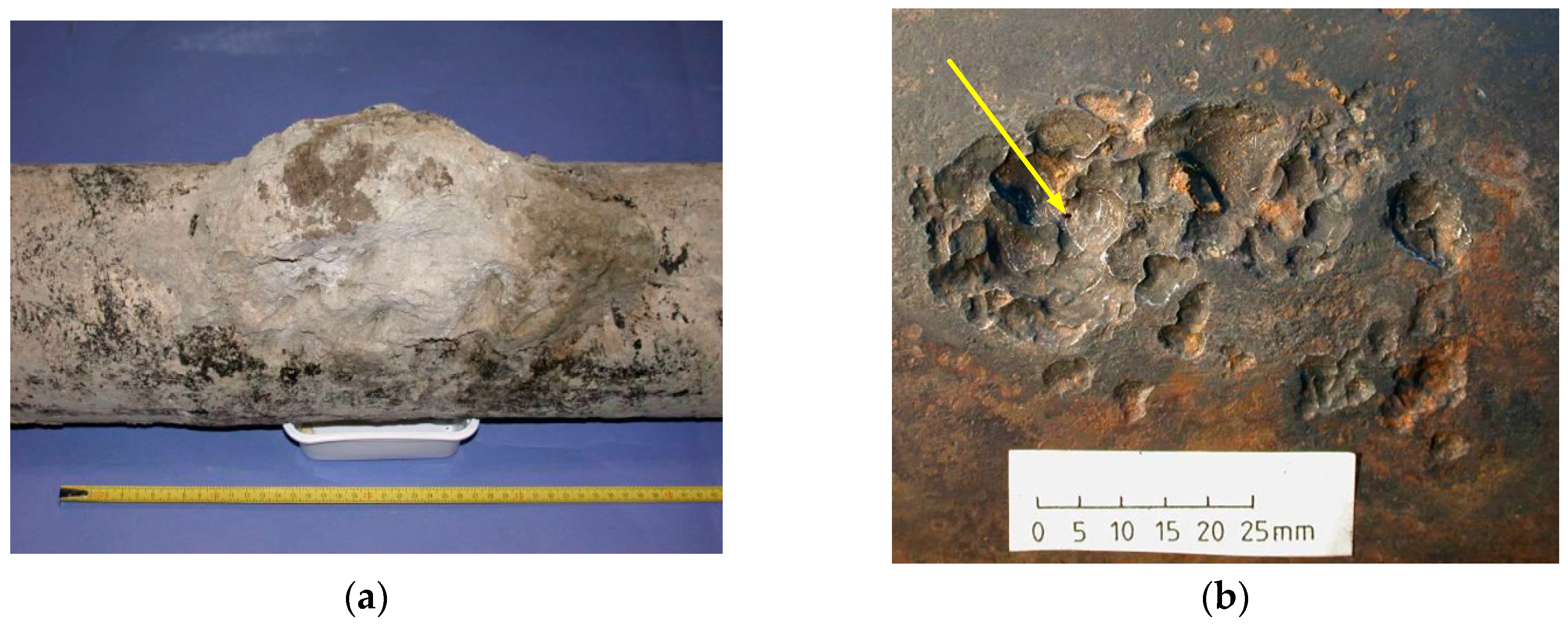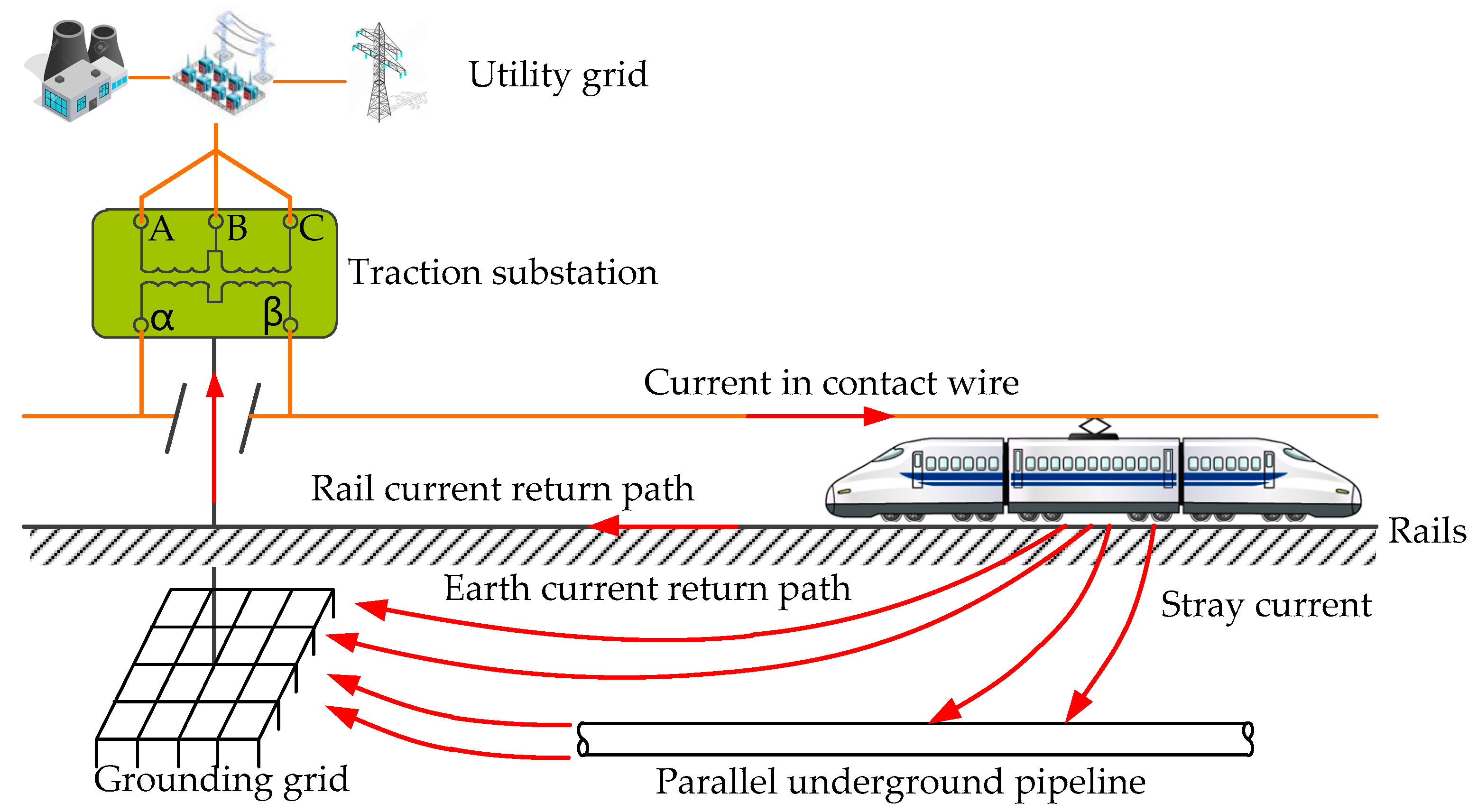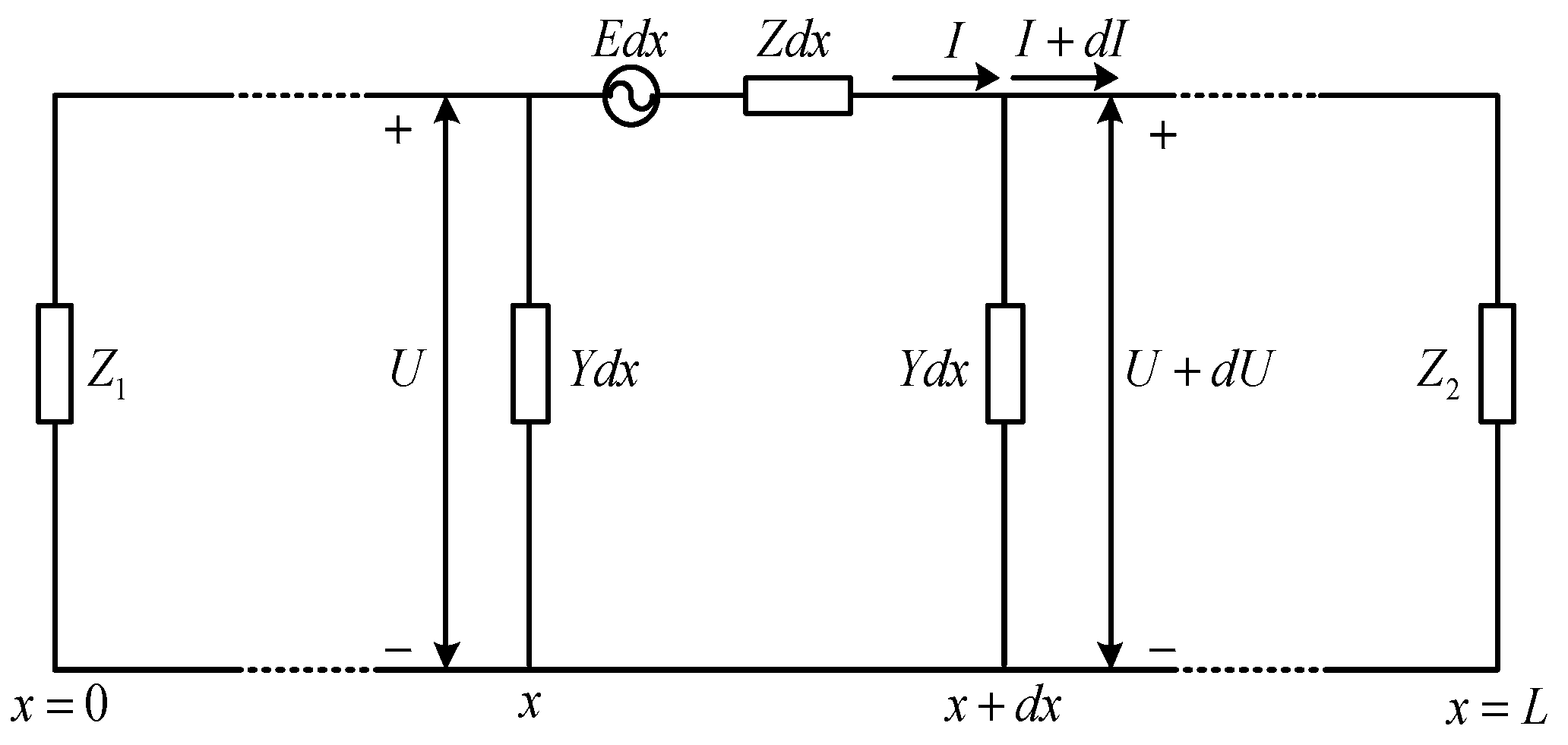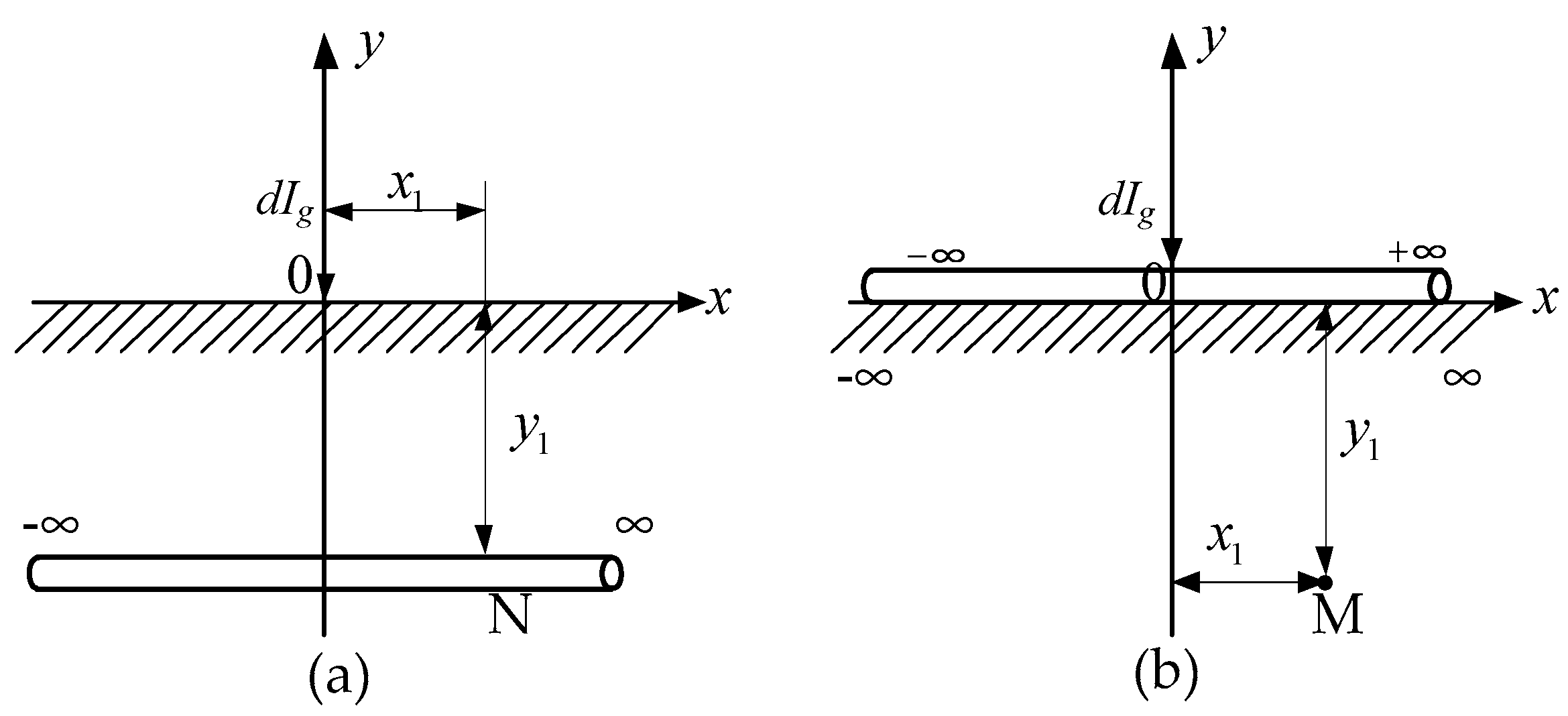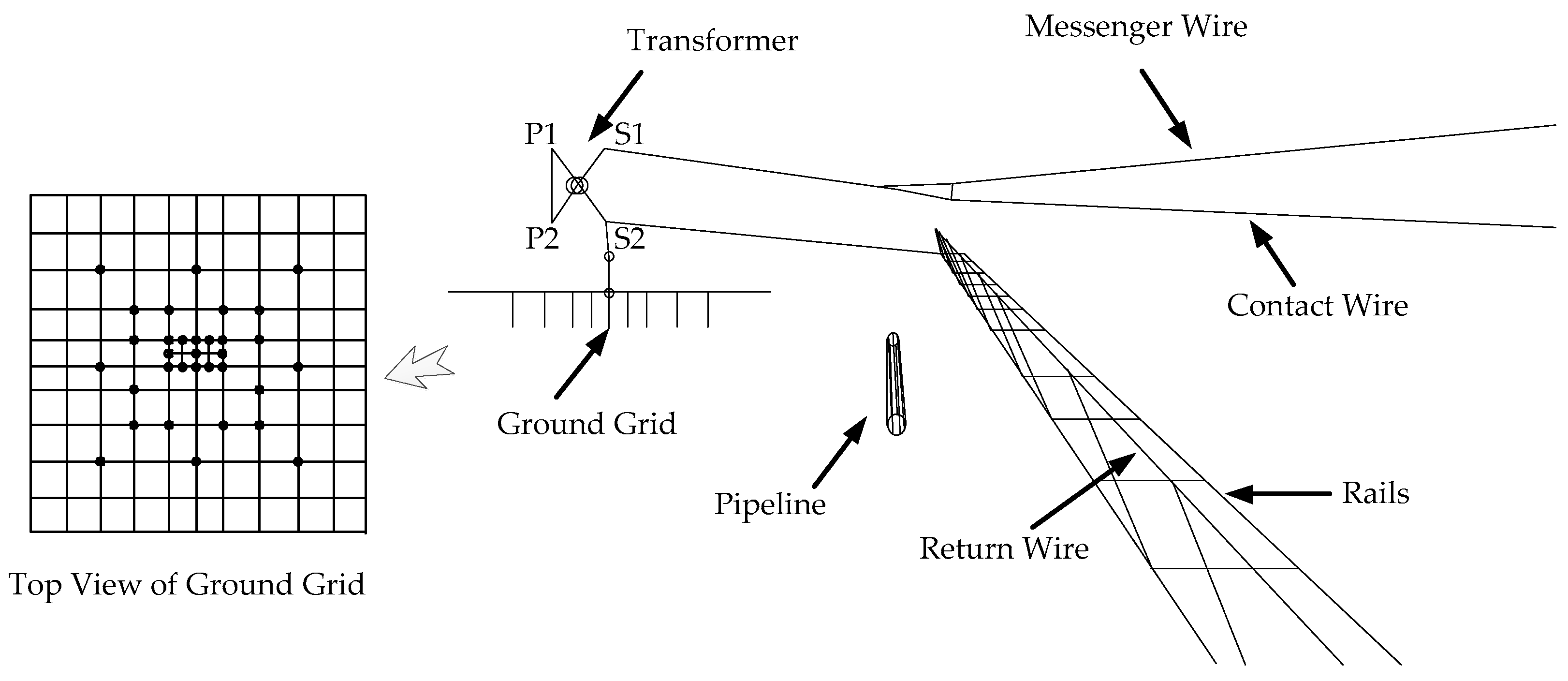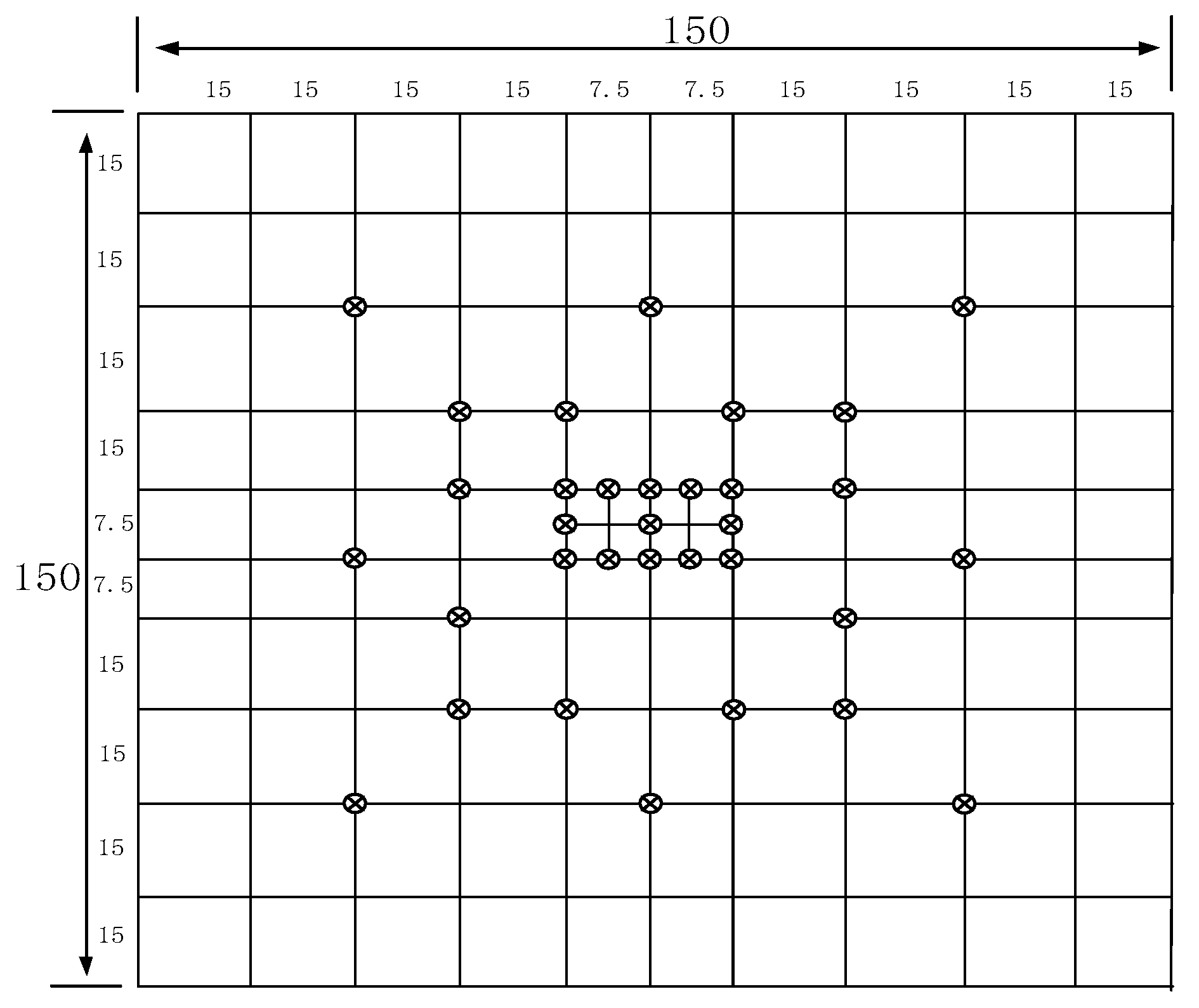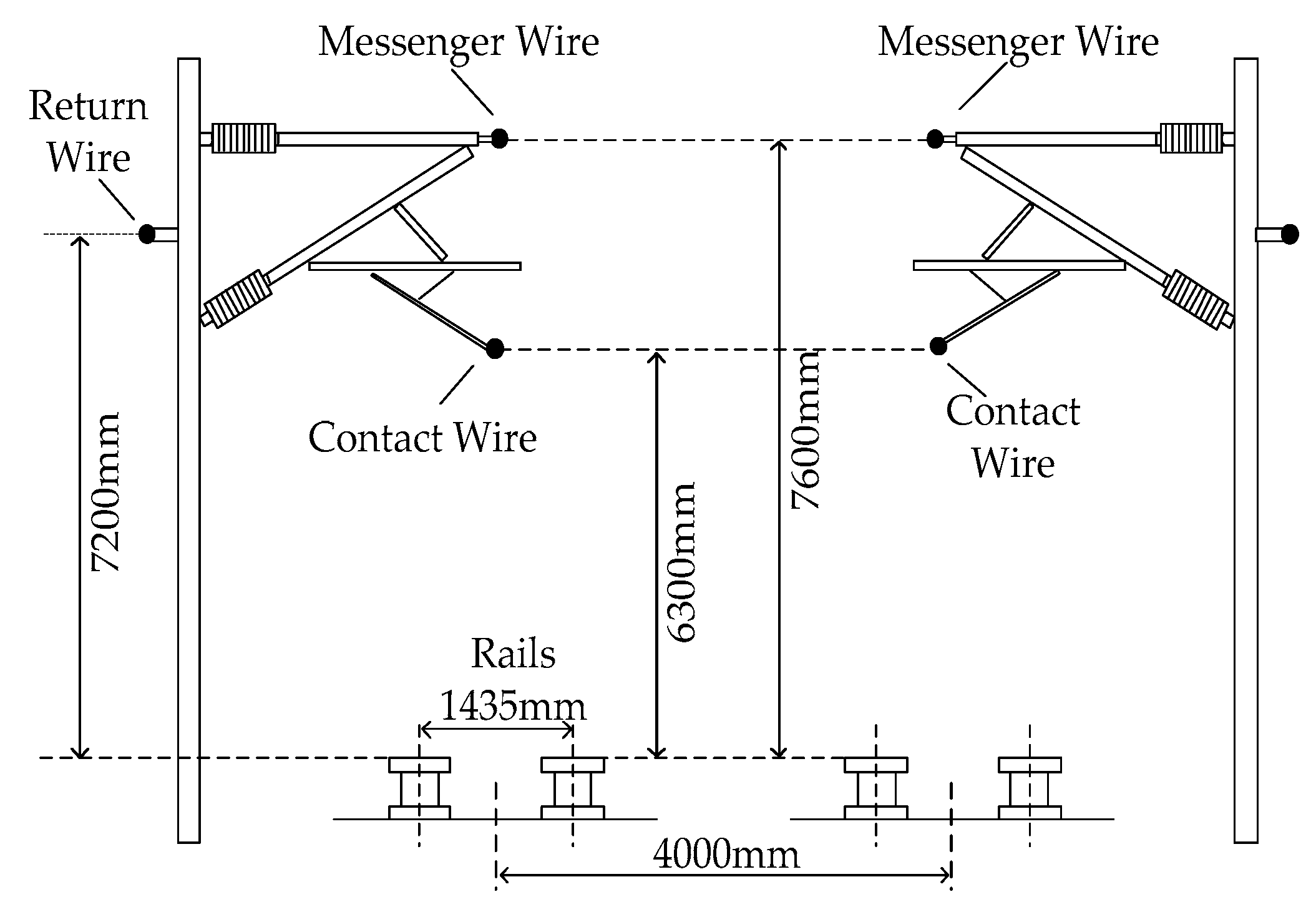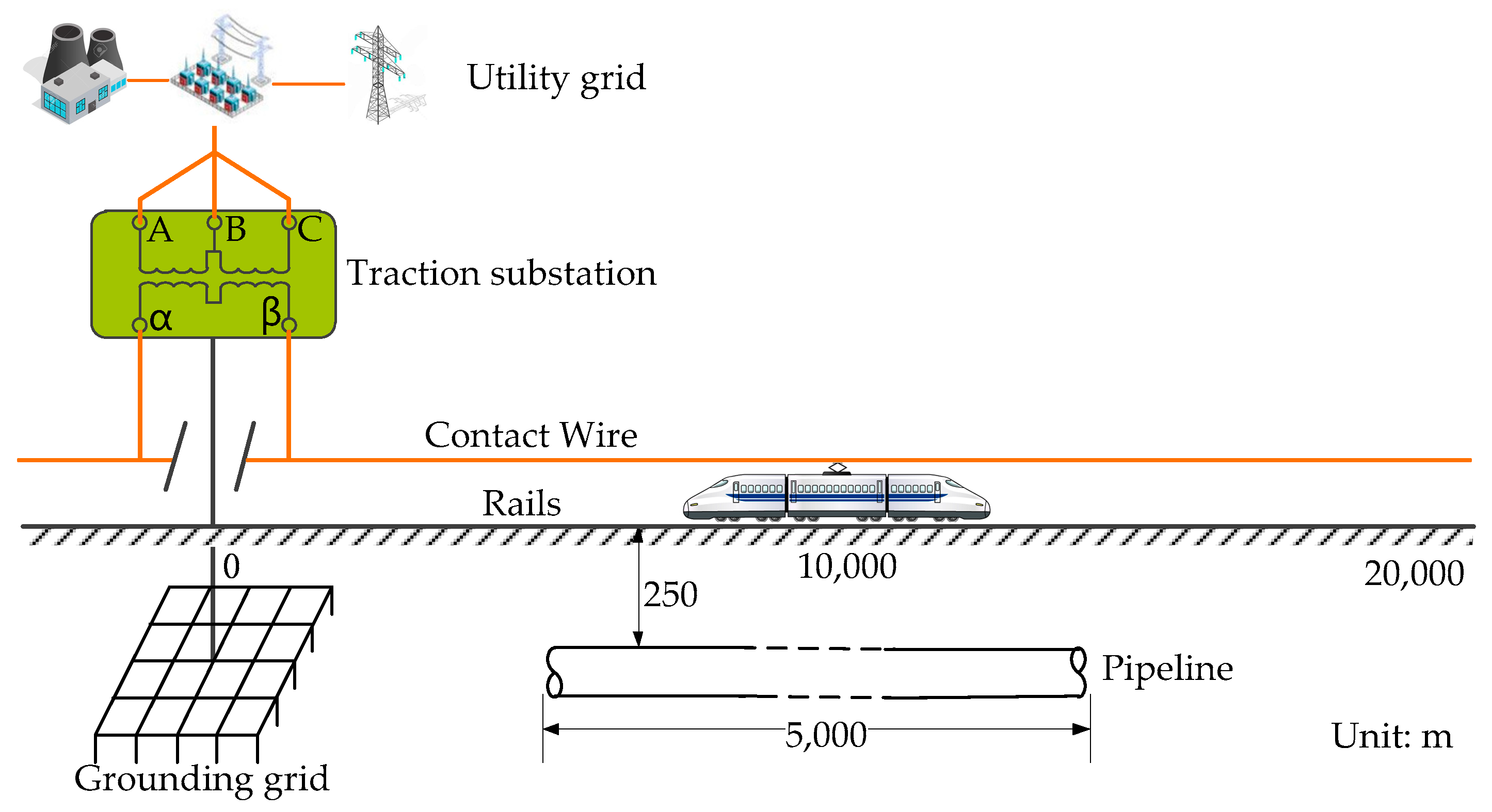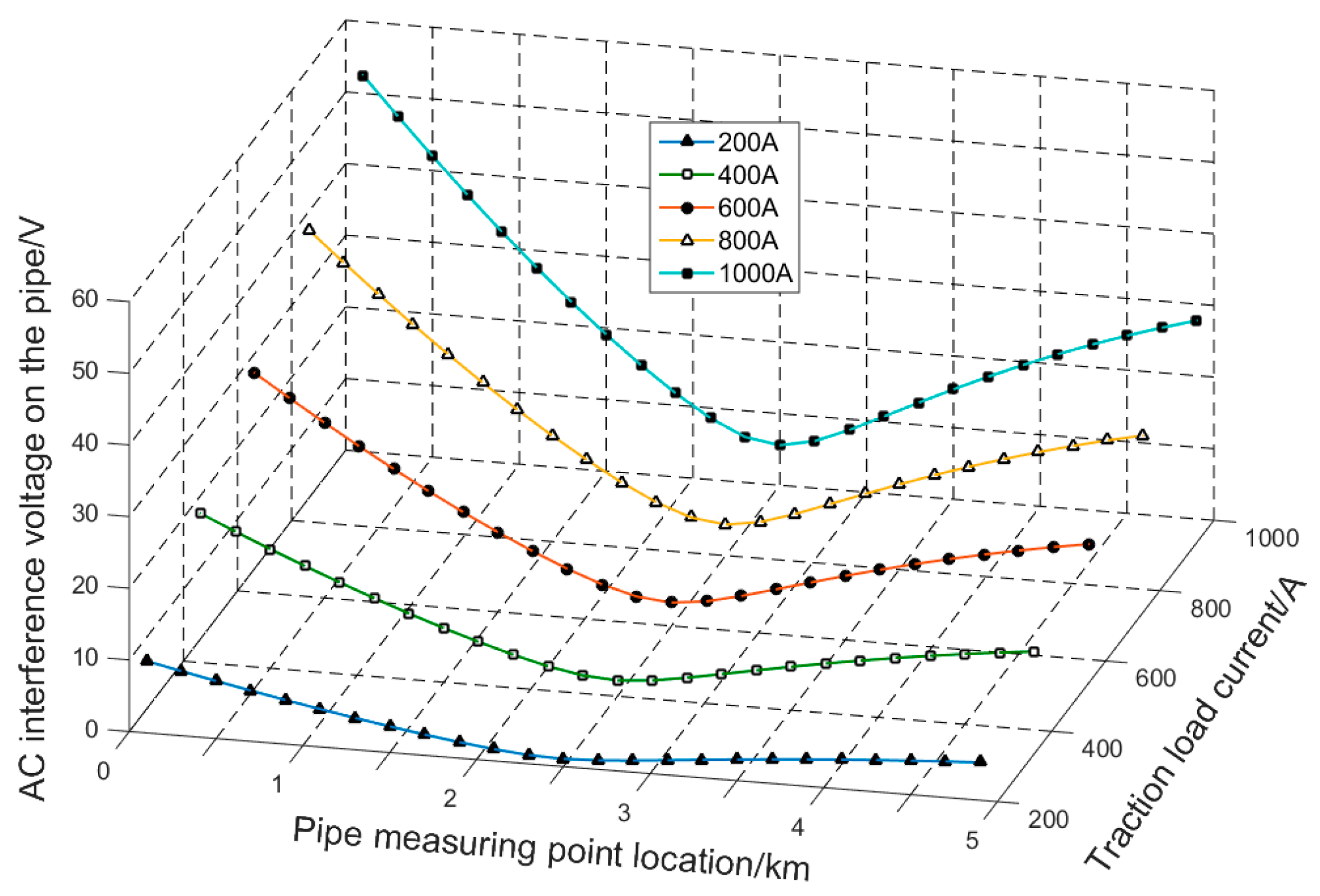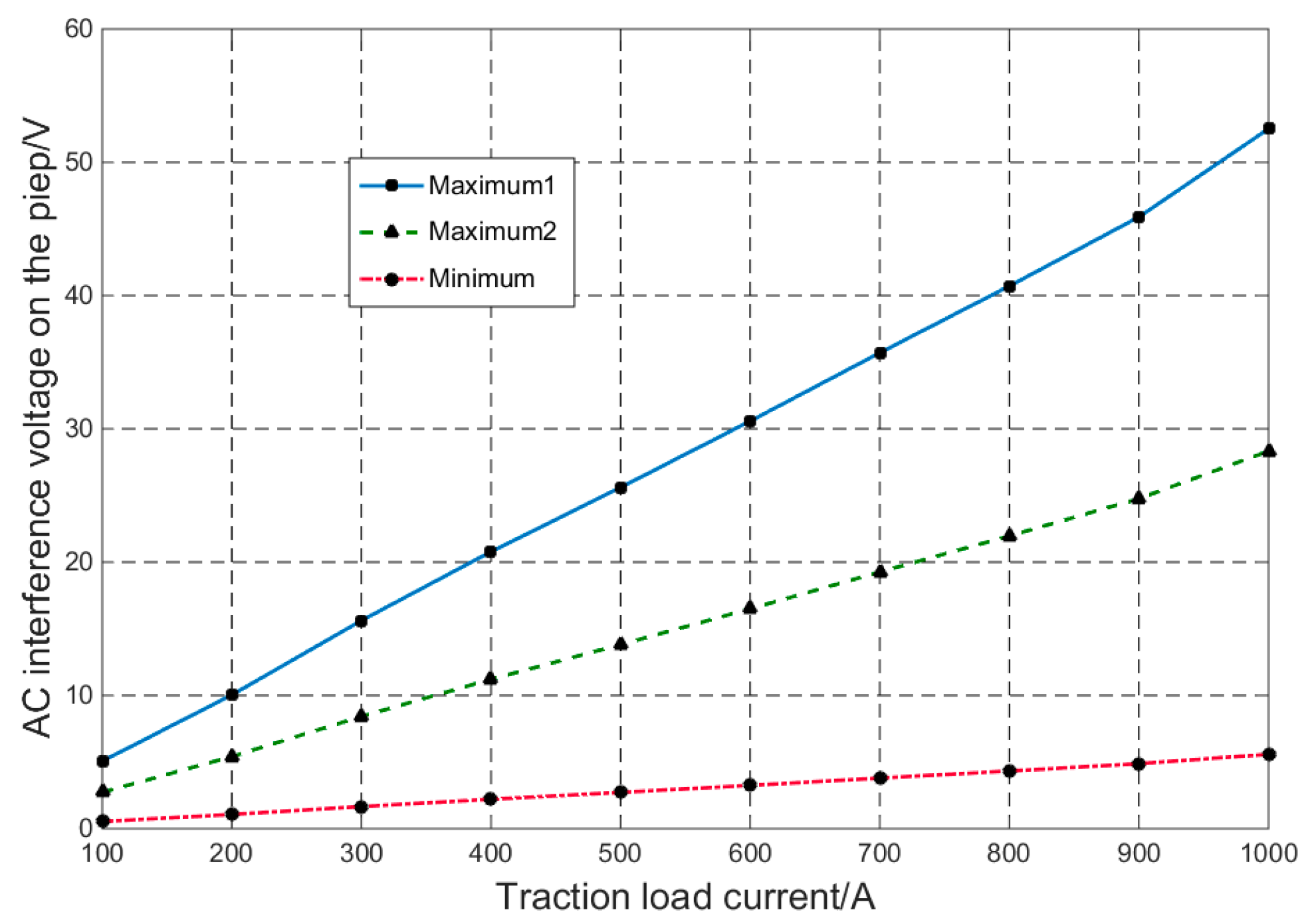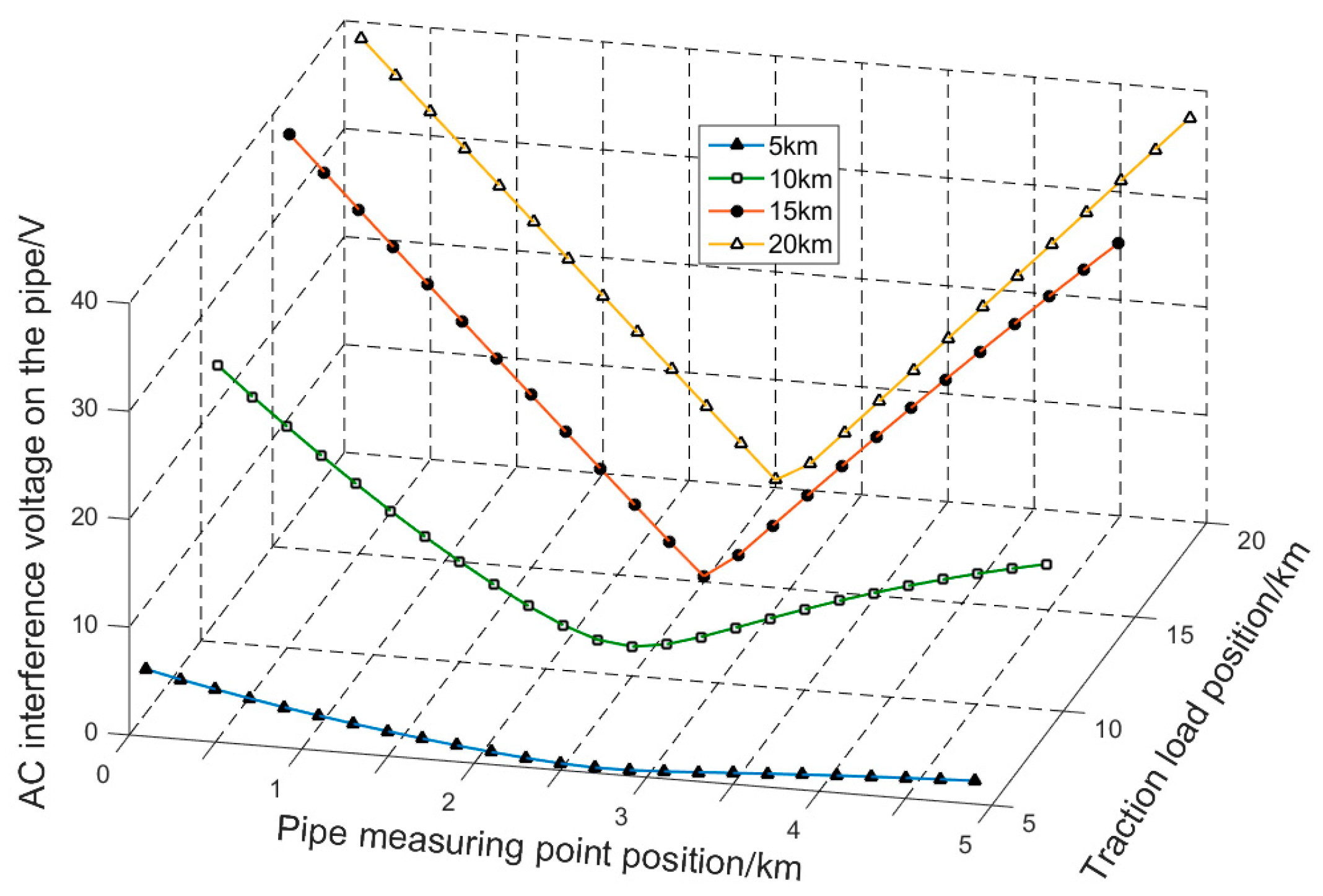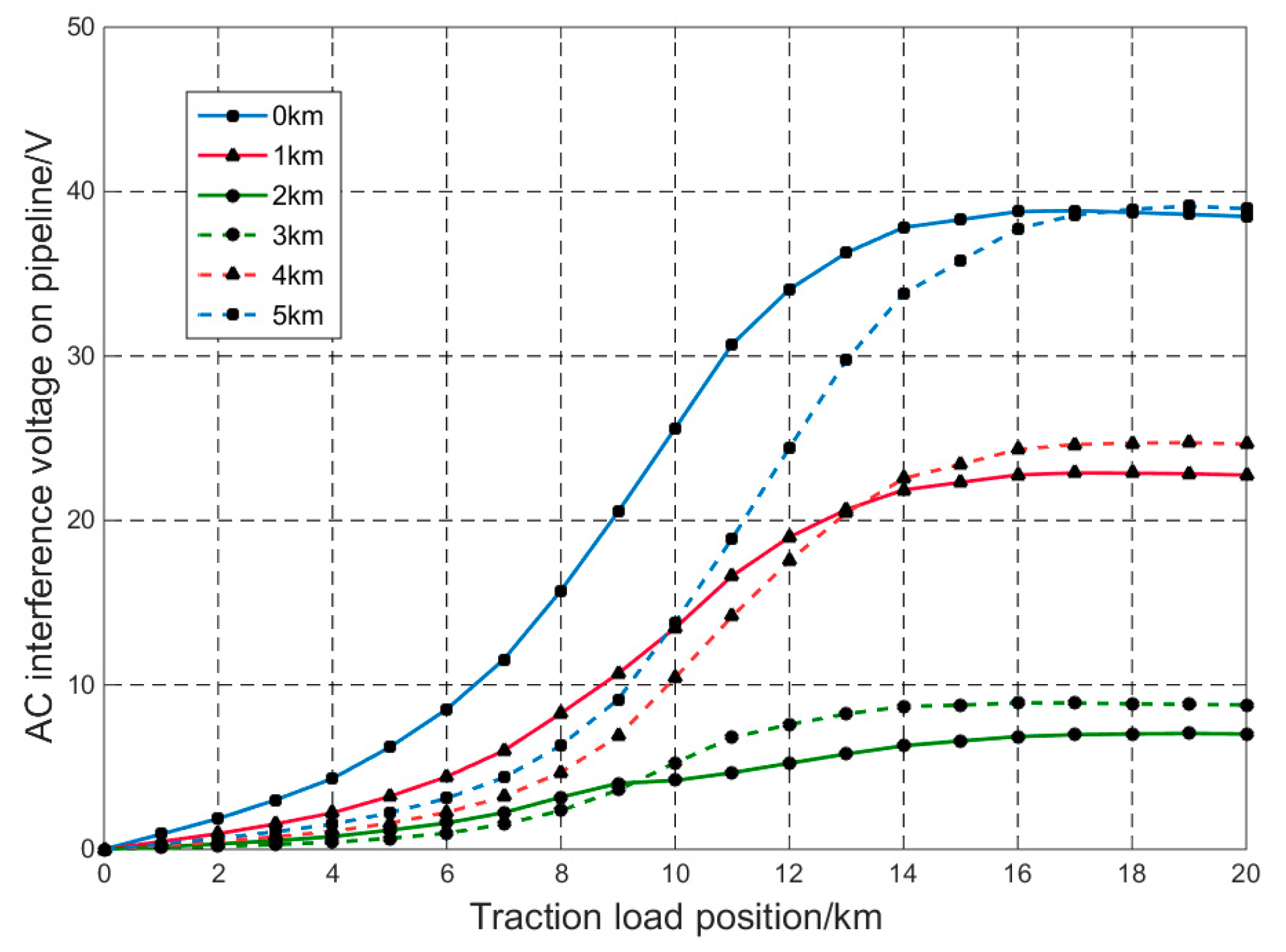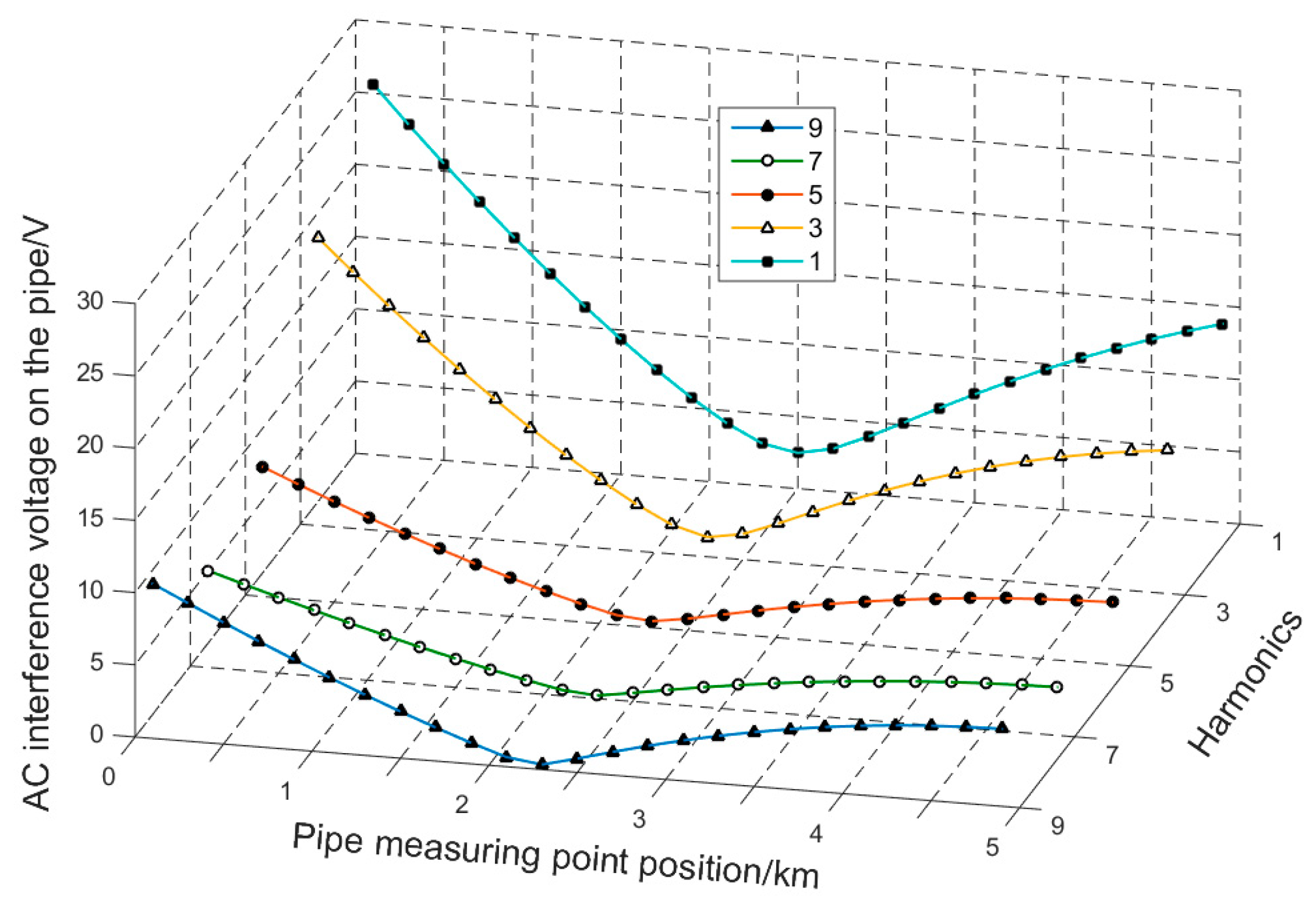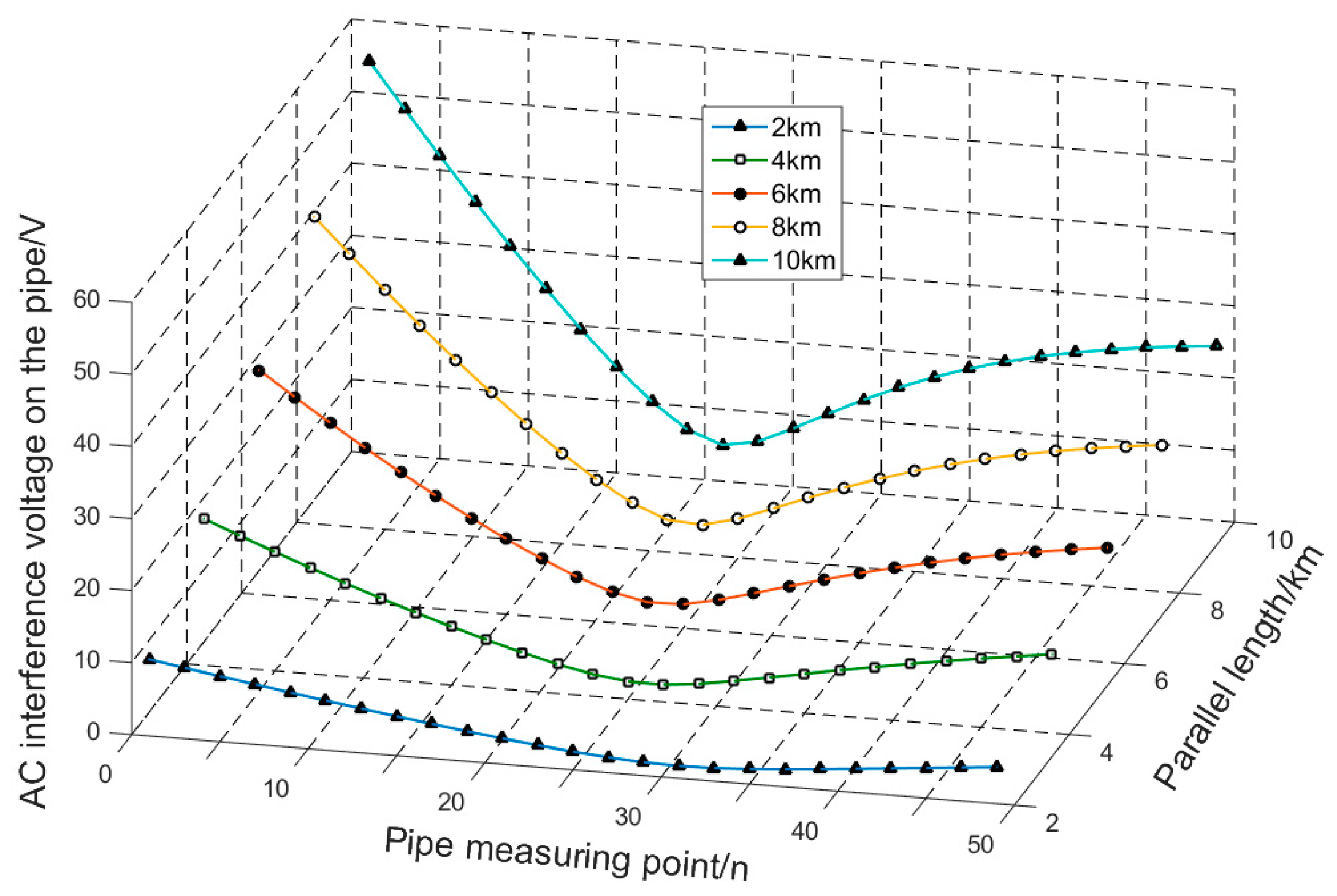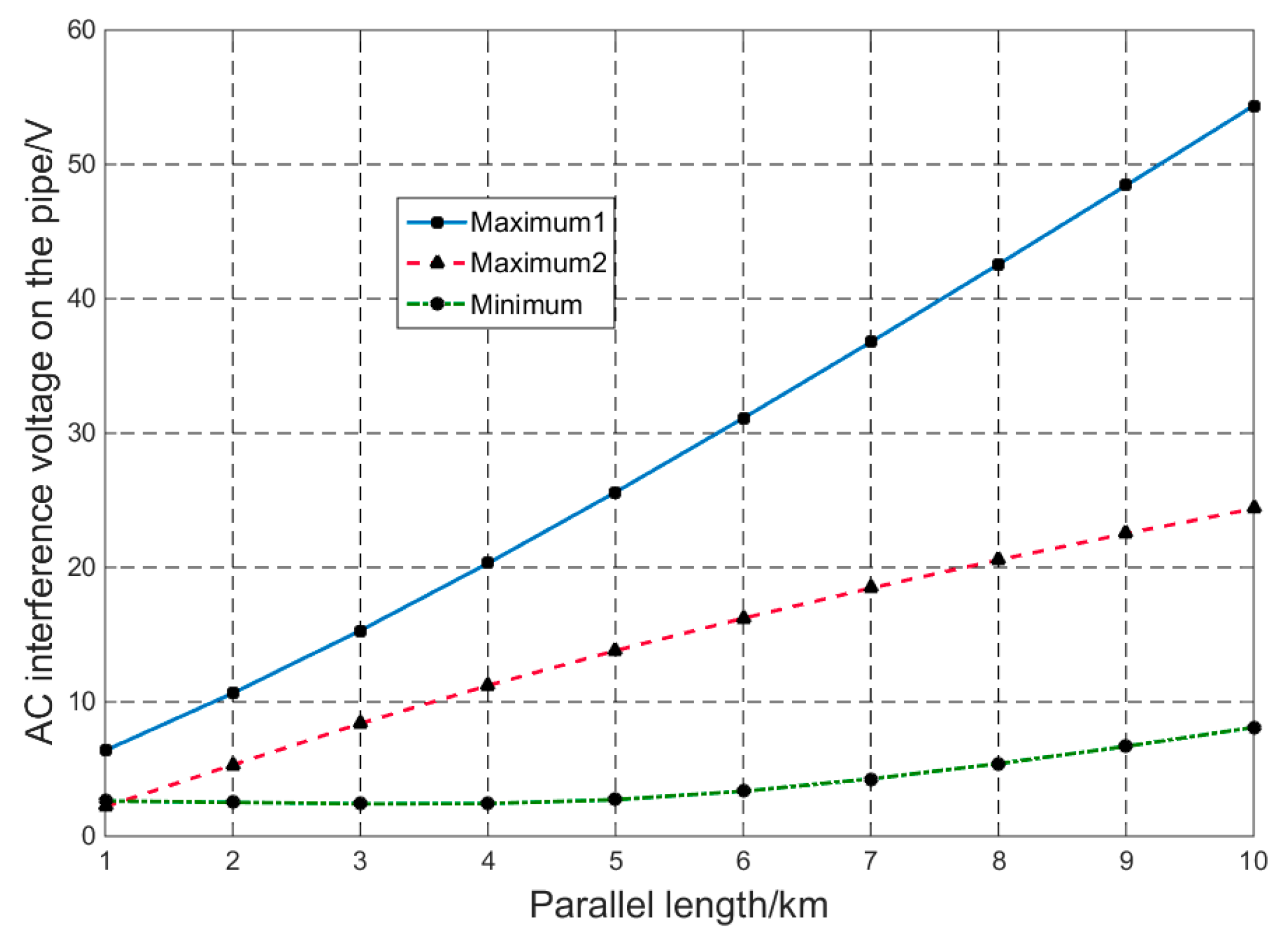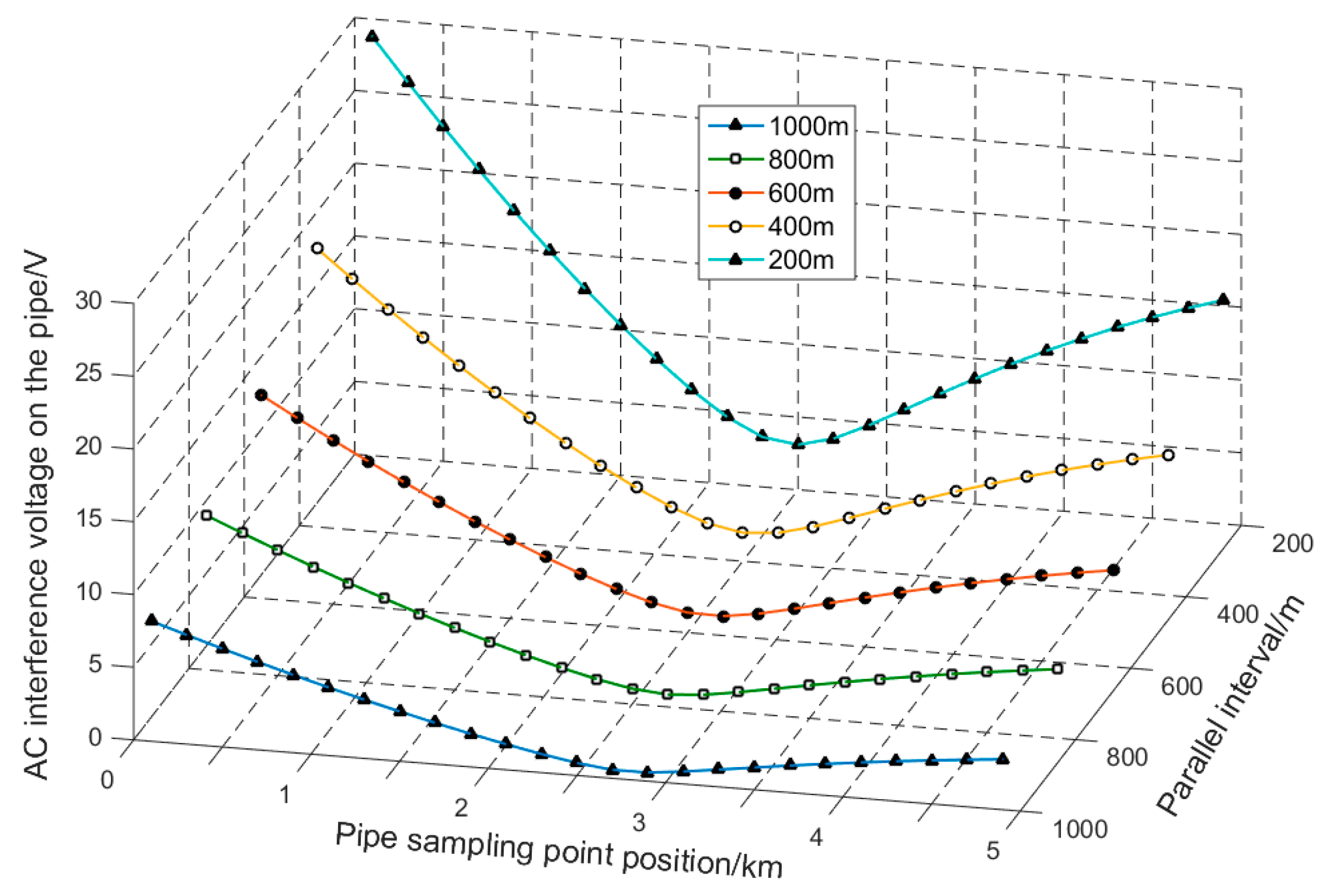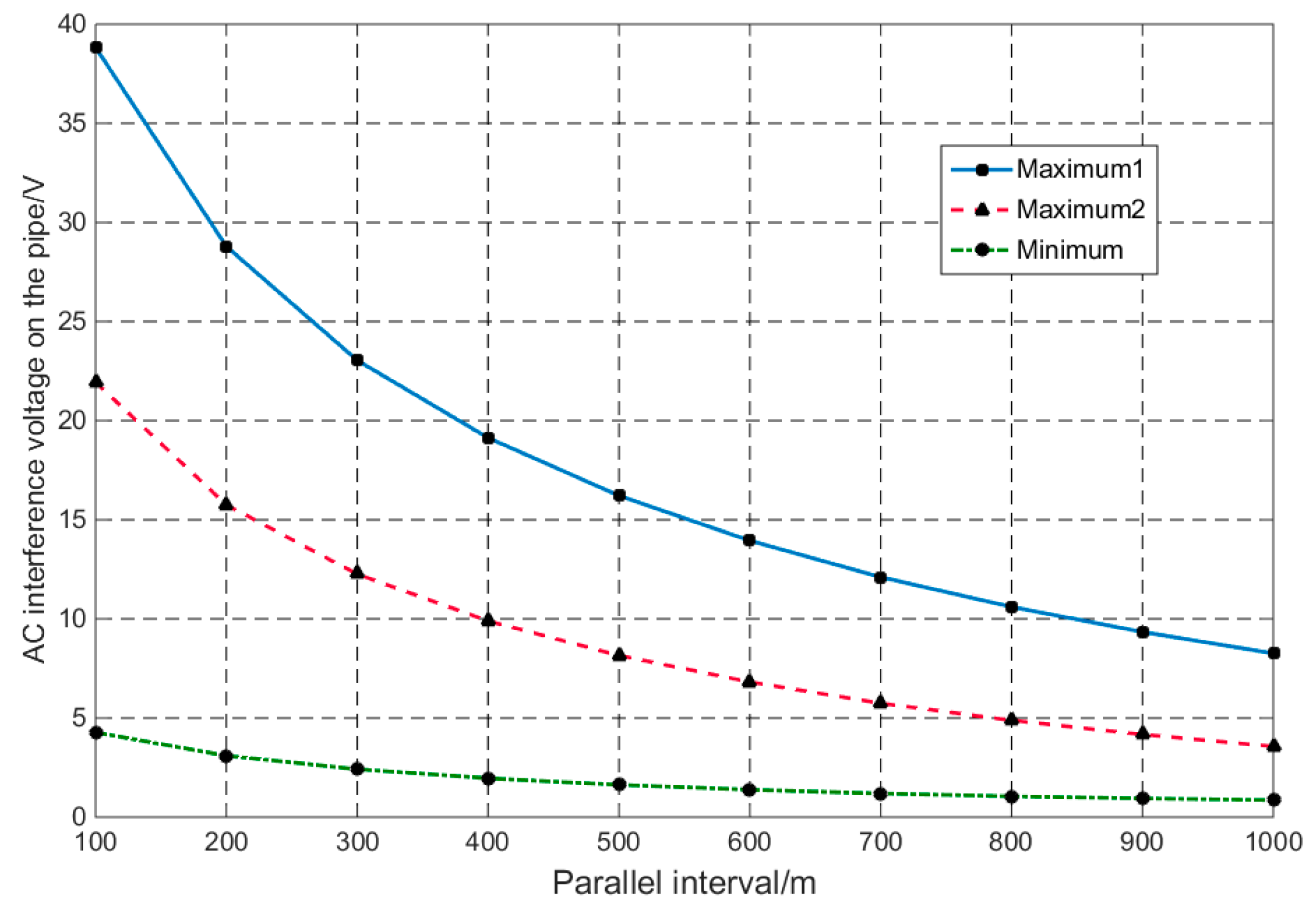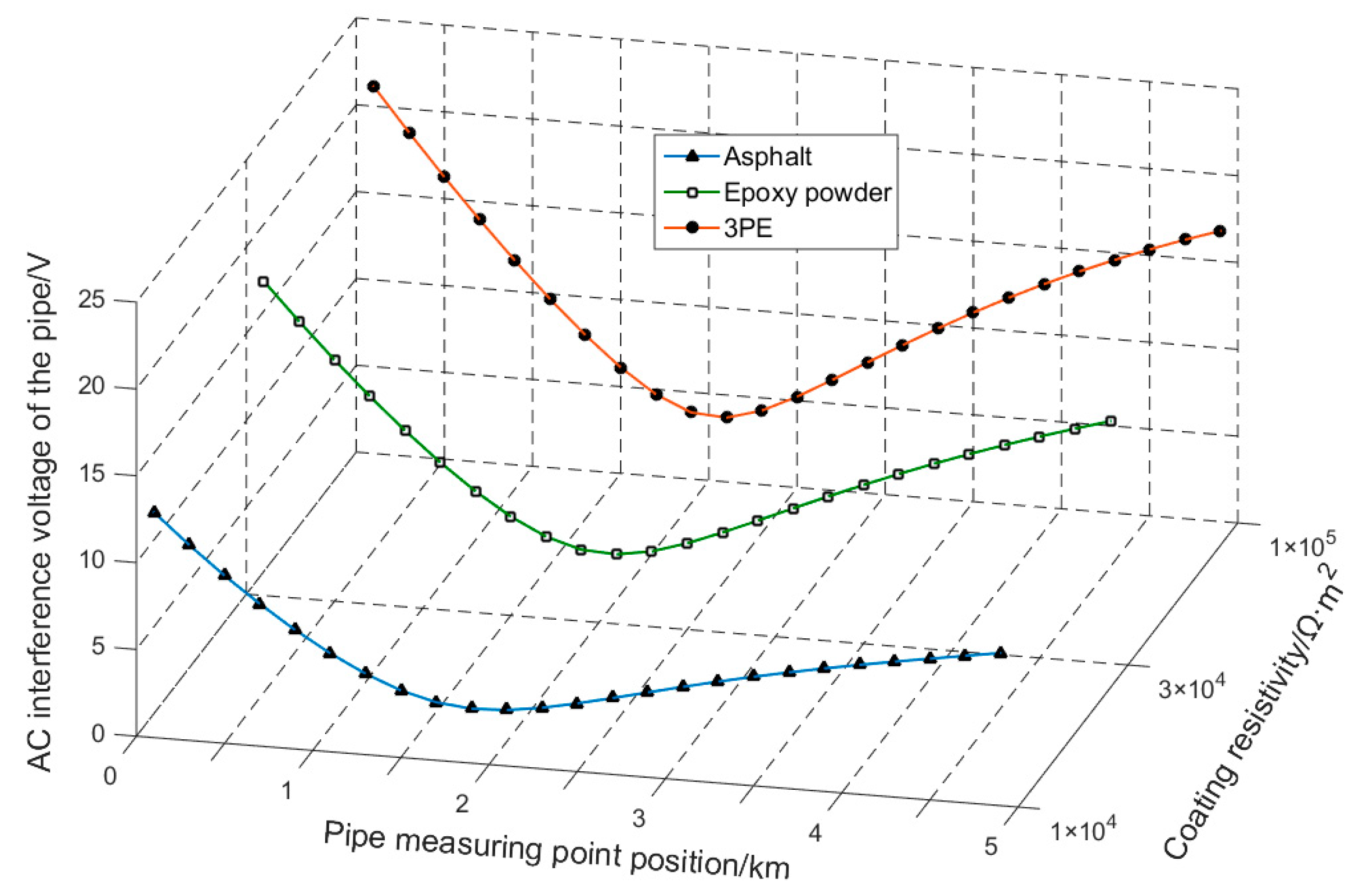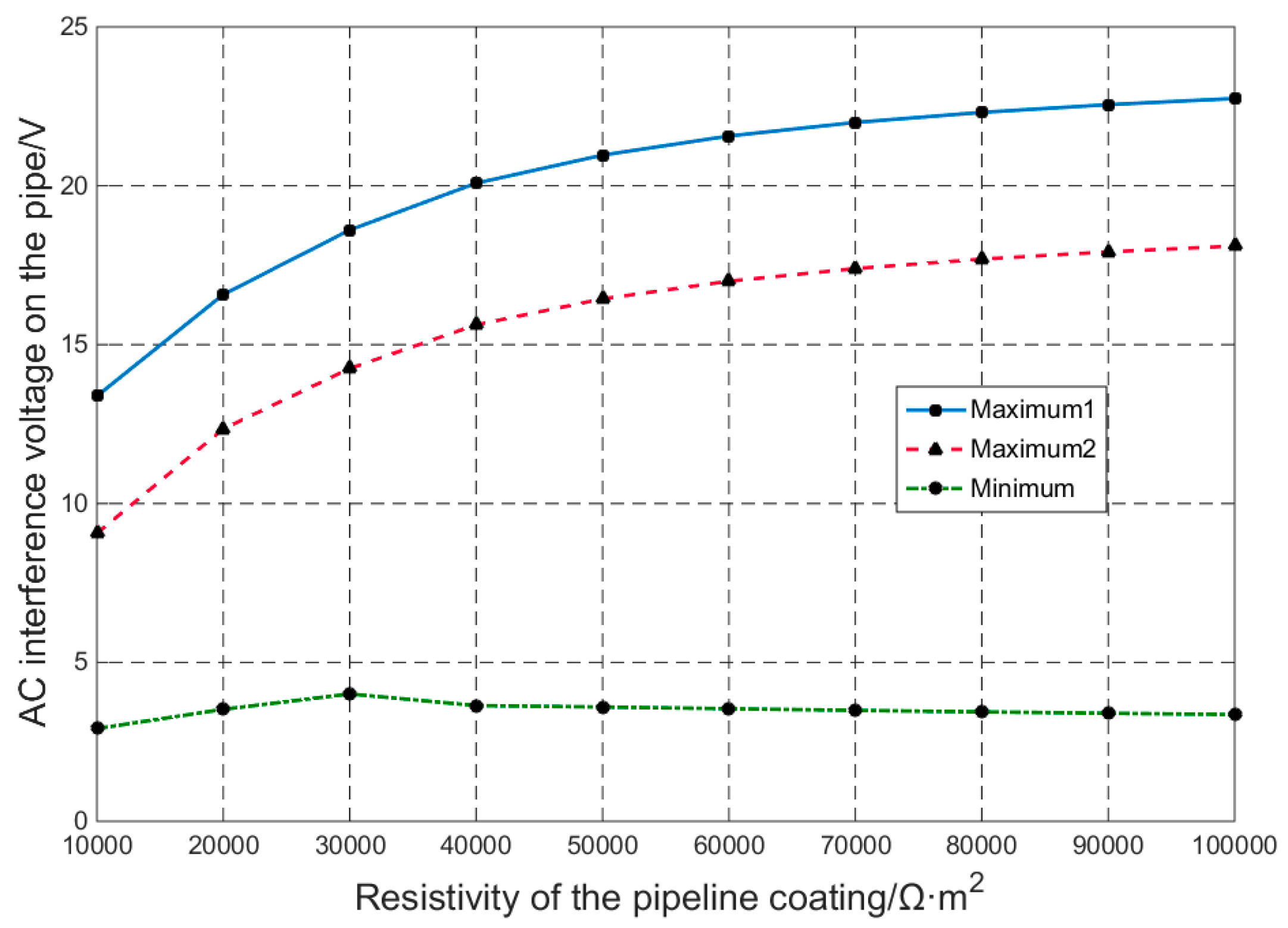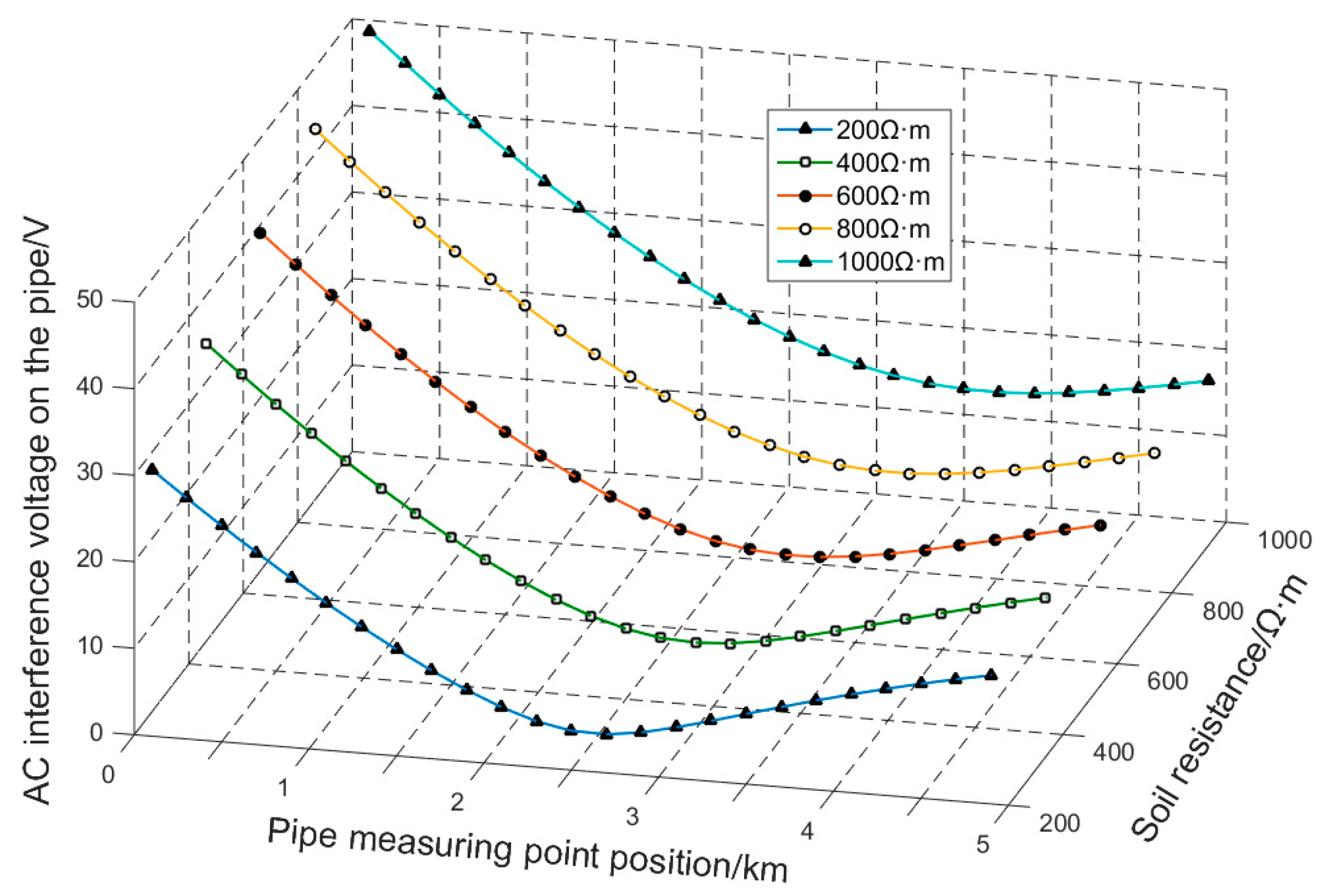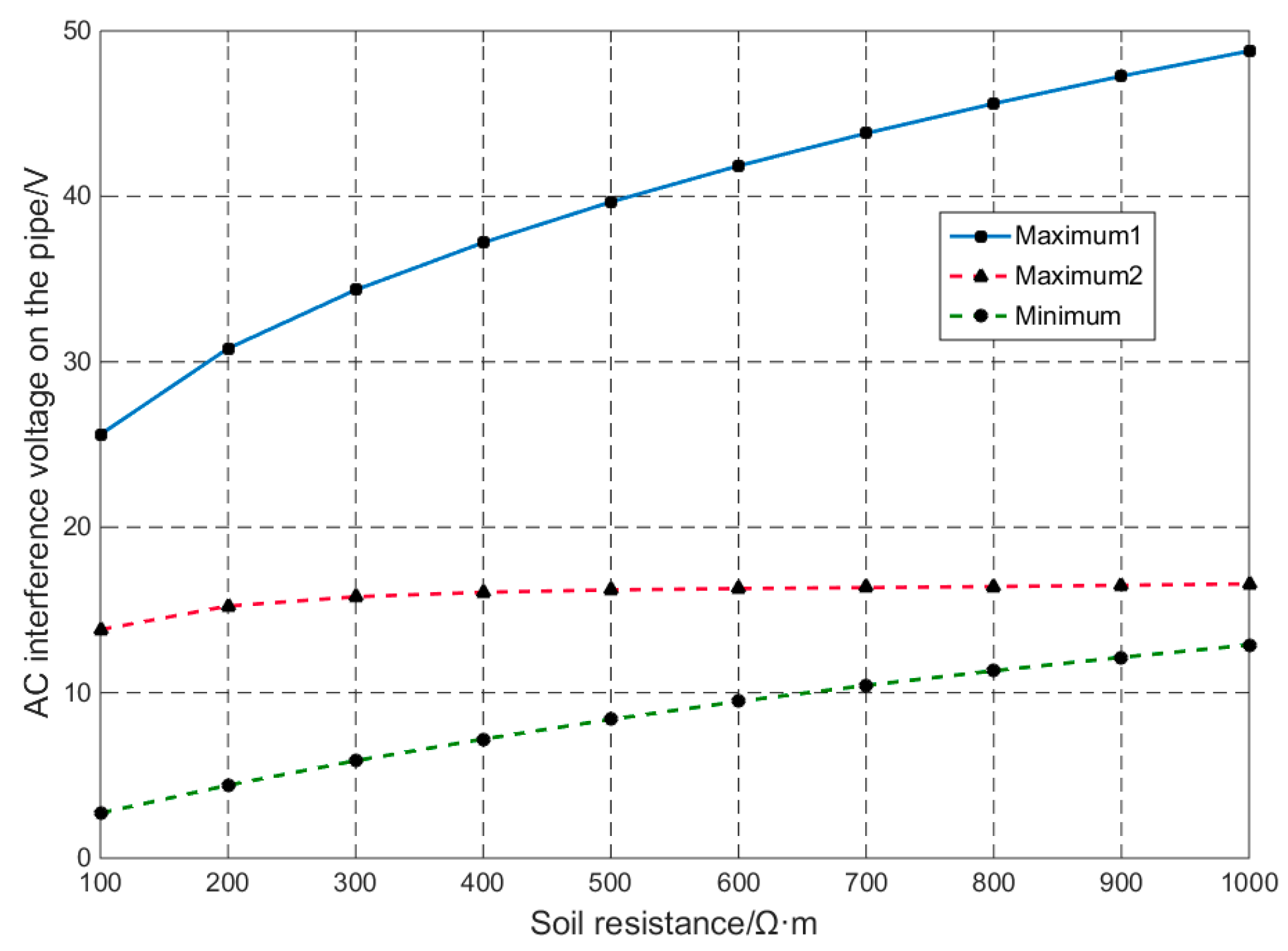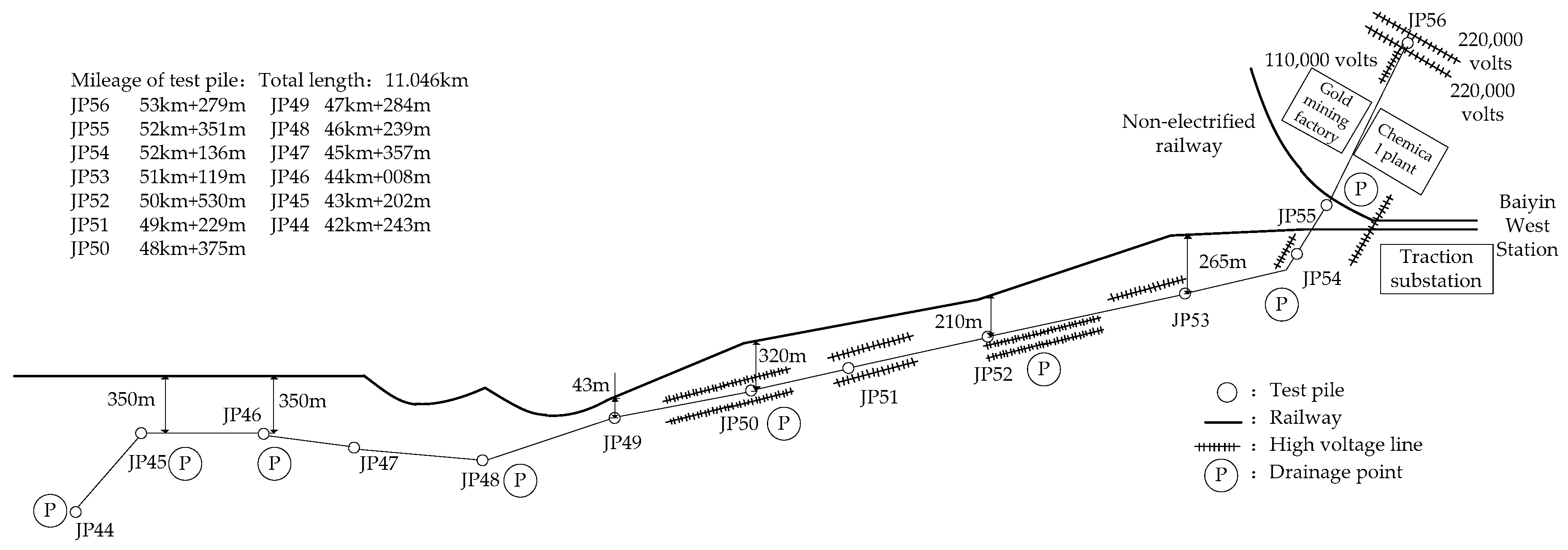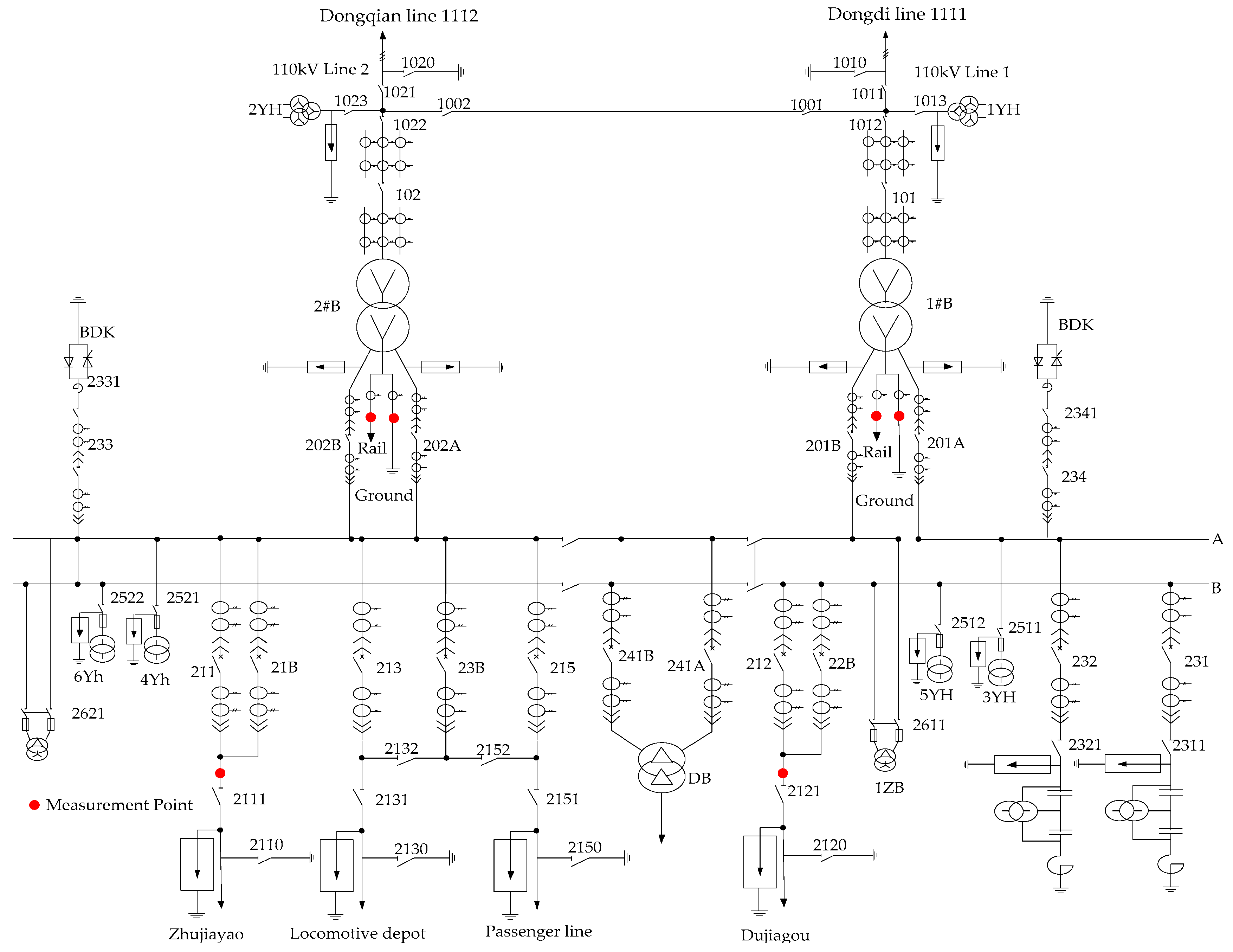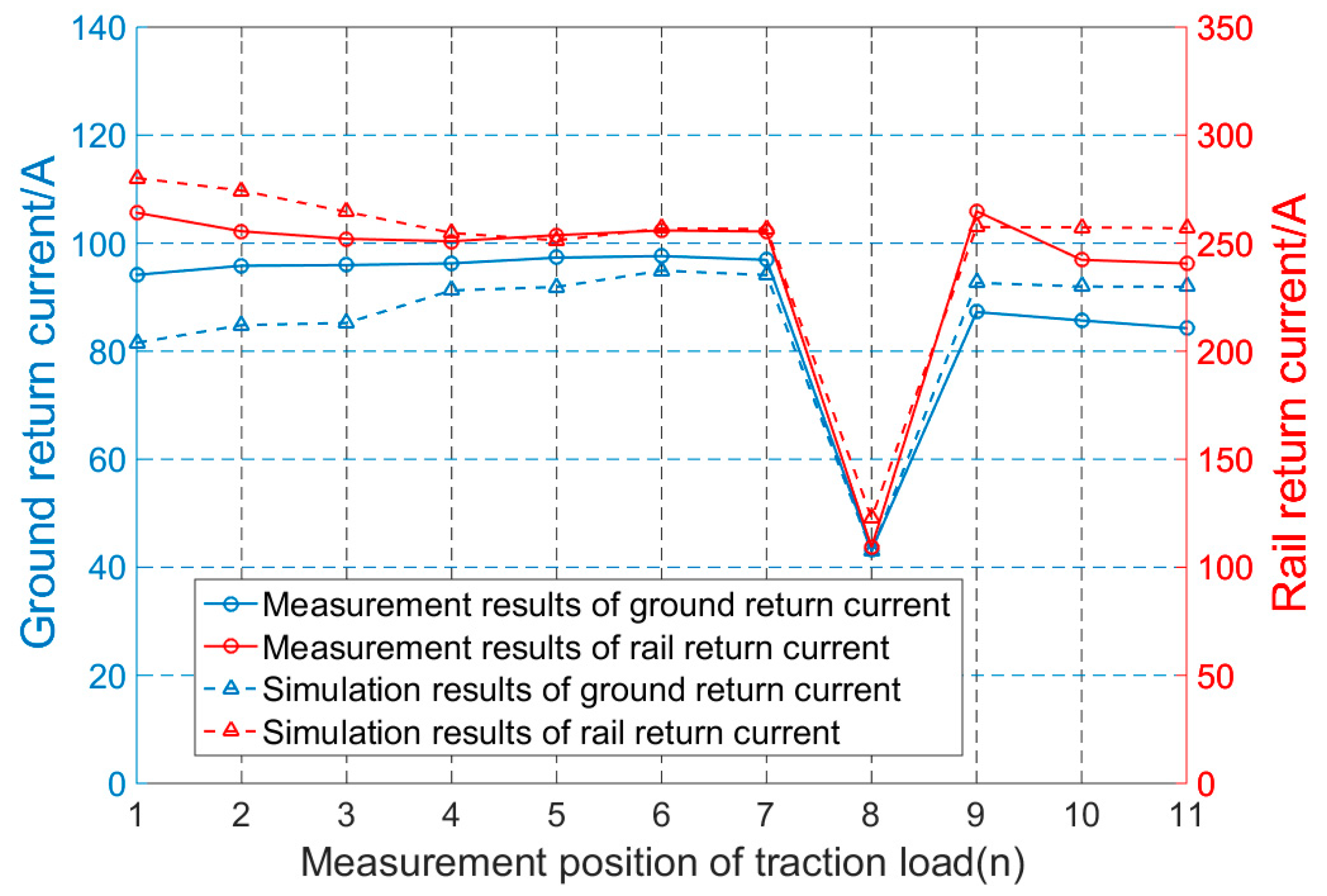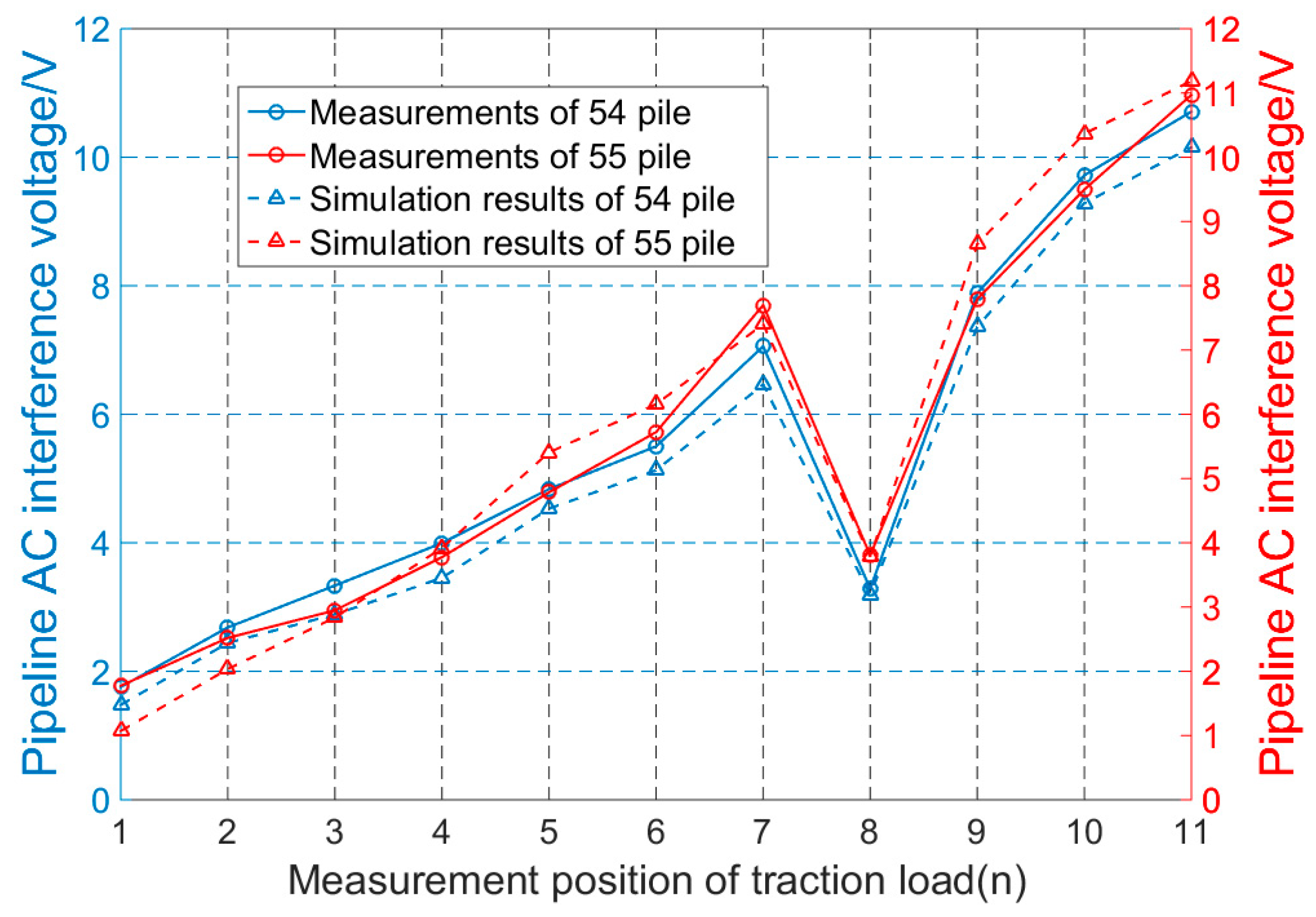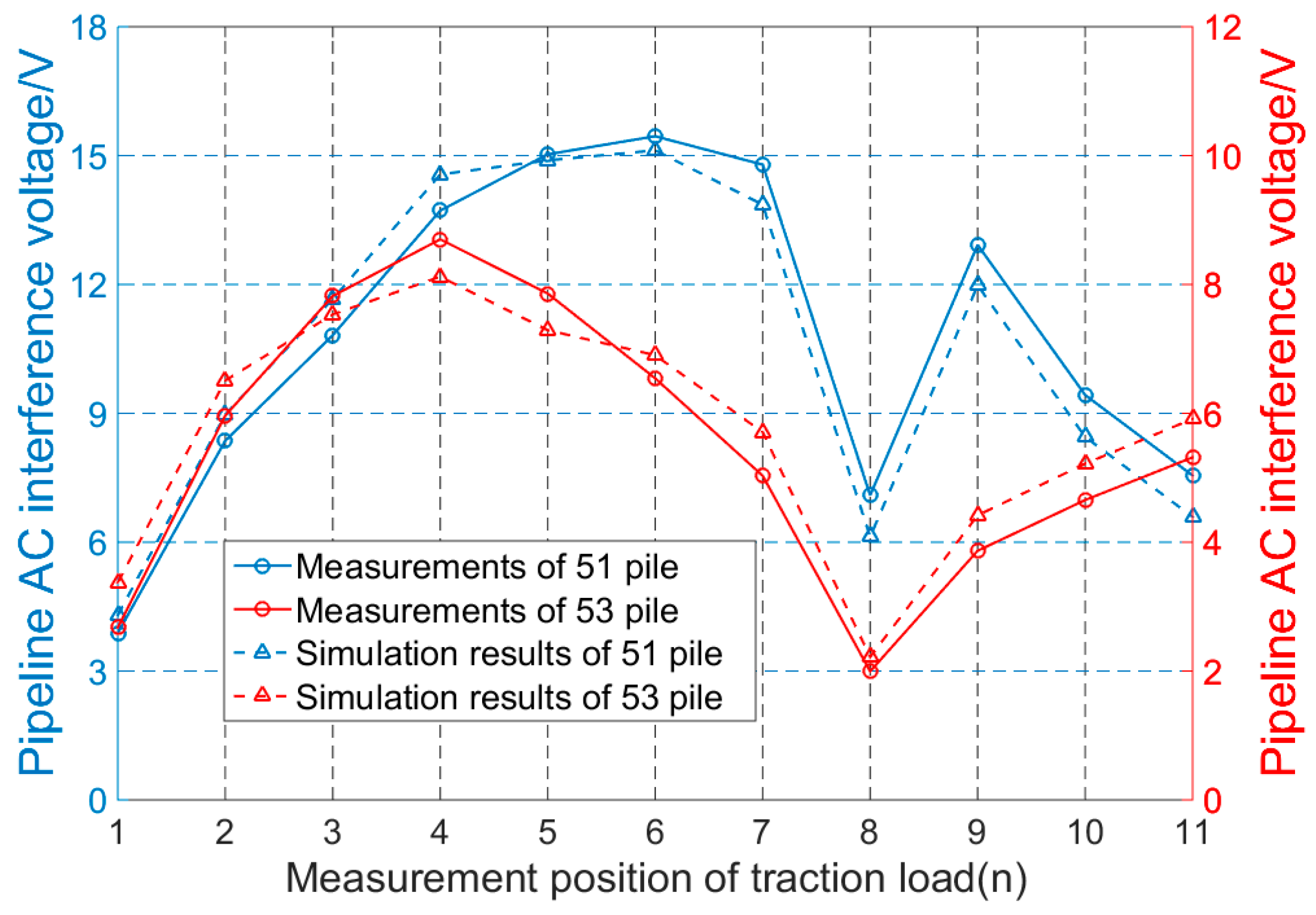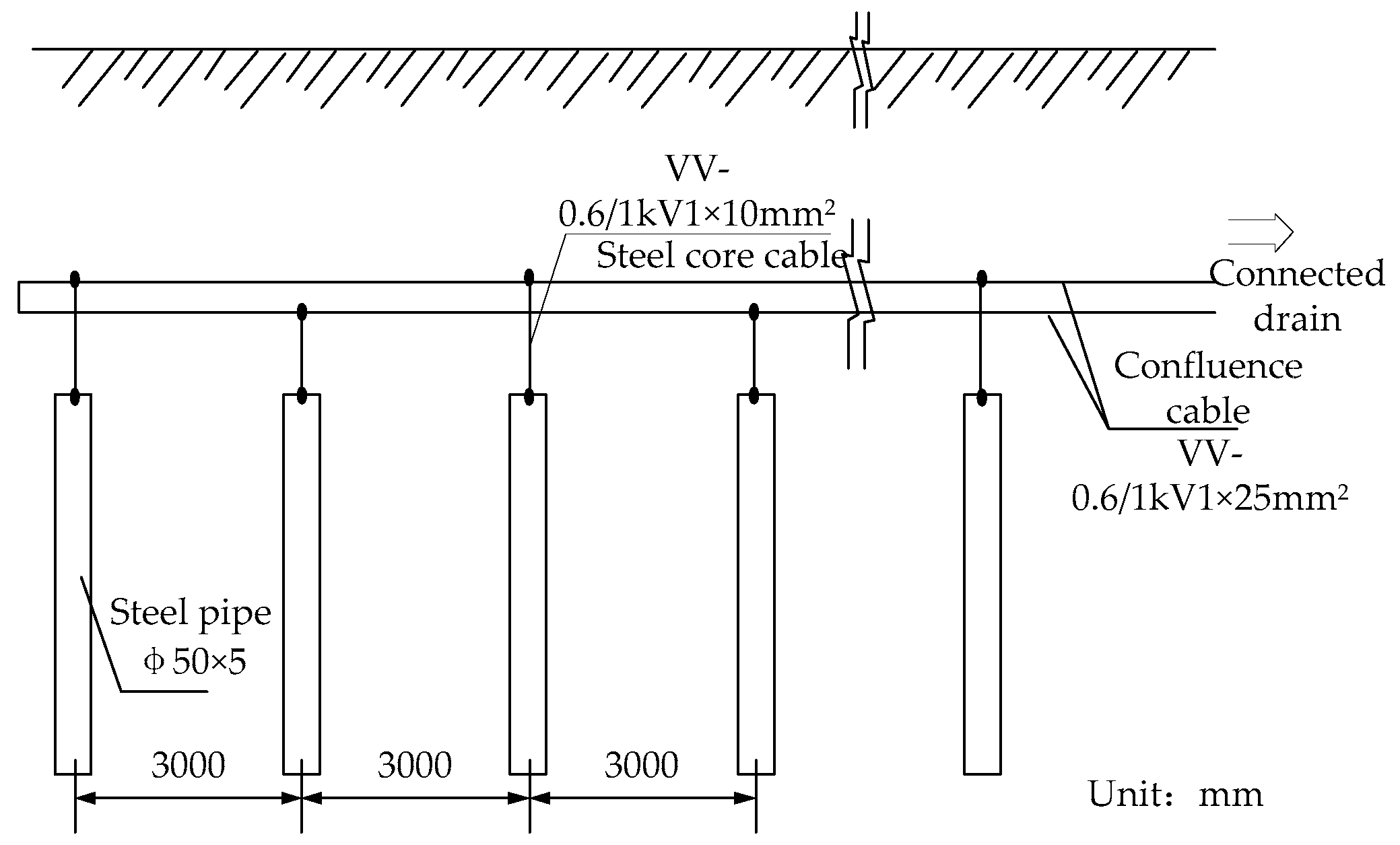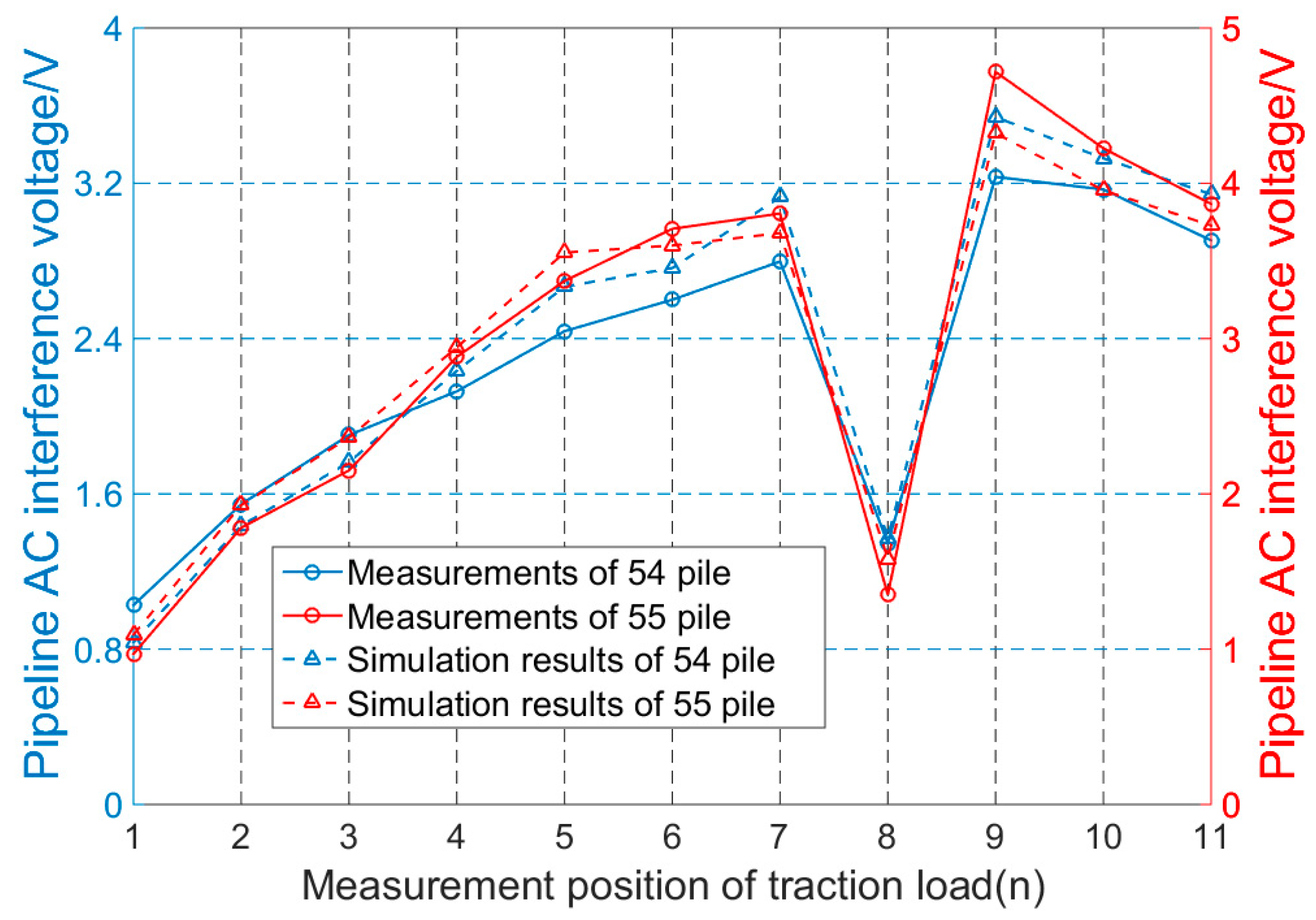Figure 1.
Leak site on underground natural gas transmission pipeline (attributed to AC corrosion). (a) Before cleaning; (b) After cleaning. The arrow indicates the leak.
Figure 1.
Leak site on underground natural gas transmission pipeline (attributed to AC corrosion). (a) Before cleaning; (b) After cleaning. The arrow indicates the leak.
Figure 2.
AC interference on a parallel underground pipeline caused by electrified railway.
Figure 2.
AC interference on a parallel underground pipeline caused by electrified railway.
Figure 3.
Calculation of inductive voltage on a parallel pipeline.
Figure 3.
Calculation of inductive voltage on a parallel pipeline.
Figure 4.
Transmission line model of the pipeline-ground electrical circuit.
Figure 4.
Transmission line model of the pipeline-ground electrical circuit.
Figure 5.
Calculation of resistive voltage on a parallel pipeline.
Figure 5.
Calculation of resistive voltage on a parallel pipeline.
Figure 6.
Interference on a parallel buried pipeline caused by ground current. (a) The electric potential at point N on the buried pipeline; (b) The electric potential on point M caused by leakage current from ground pipeline.
Figure 6.
Interference on a parallel buried pipeline caused by ground current. (a) The electric potential at point N on the buried pipeline; (b) The electric potential on point M caused by leakage current from ground pipeline.
Figure 7.
Model for AC interference on parallel buried pipelines caused by an electrified railway.
Figure 7.
Model for AC interference on parallel buried pipelines caused by an electrified railway.
Figure 8.
X-Z plan view of the grounding grid.
Figure 8.
X-Z plan view of the grounding grid.
Figure 9.
Topological arrangement of a single-phase AC traction supply and supporting system.
Figure 9.
Topological arrangement of a single-phase AC traction supply and supporting system.
Figure 10.
Relative positions between the electrified railways and buried pipelines.
Figure 10.
Relative positions between the electrified railways and buried pipelines.
Figure 11.
Influence of traction load current on AC interference voltage distribution on the pipeline.
Figure 11.
Influence of traction load current on AC interference voltage distribution on the pipeline.
Figure 12.
The distribution of AC interference voltages on the pipeline with different traction load current.
Figure 12.
The distribution of AC interference voltages on the pipeline with different traction load current.
Figure 13.
Influence of traction load location on AC interference voltage distribution on the pipeline.
Figure 13.
Influence of traction load location on AC interference voltage distribution on the pipeline.
Figure 14.
The distribution of AC interference voltages on the pipeline with different traction load position.
Figure 14.
The distribution of AC interference voltages on the pipeline with different traction load position.
Figure 15.
Influence of harmonics on the AC interference voltage distribution on the pipeline.
Figure 15.
Influence of harmonics on the AC interference voltage distribution on the pipeline.
Figure 16.
Influence of parallel length on AC interference voltage distribution on the pipeline.
Figure 16.
Influence of parallel length on AC interference voltage distribution on the pipeline.
Figure 17.
The distribution of AC interference voltages of the pipeline with different parallel lengths.
Figure 17.
The distribution of AC interference voltages of the pipeline with different parallel lengths.
Figure 18.
Influence of parallel interval on AC interference voltage distribution on the pipeline.
Figure 18.
Influence of parallel interval on AC interference voltage distribution on the pipeline.
Figure 19.
The distribution of AC interference voltages of the pipeline with different parallel intervals.
Figure 19.
The distribution of AC interference voltages of the pipeline with different parallel intervals.
Figure 20.
Influence of pipe coatings on AC interference voltage distribution on the pipeline.
Figure 20.
Influence of pipe coatings on AC interference voltage distribution on the pipeline.
Figure 21.
The distribution of AC interference voltages of the pipeline with different coating resistances.
Figure 21.
The distribution of AC interference voltages of the pipeline with different coating resistances.
Figure 22.
Influence of soil resistance on AC interference voltage distribution.
Figure 22.
Influence of soil resistance on AC interference voltage distribution.
Figure 23.
The distribution of AC interference voltages of the pipeline with different soil resistances.
Figure 23.
The distribution of AC interference voltages of the pipeline with different soil resistances.
Figure 24.
Schematic diagram of the Baolan railway and the Baiyin branch pipeline.
Figure 24.
Schematic diagram of the Baolan railway and the Baiyin branch pipeline.
Figure 25.
Electrical diagram of the Baiyin West traction substation.
Figure 25.
Electrical diagram of the Baiyin West traction substation.
Figure 26.
The results of the traction return current (traction load current is 350 A).
Figure 26.
The results of the traction return current (traction load current is 350 A).
Figure 27.
Comparison of measurement and simulation of the undraining condition in the cross section.
Figure 27.
Comparison of measurement and simulation of the undraining condition in the cross section.
Figure 28.
Comparison of measurement and simulation of the undraining condition in the parallel section.
Figure 28.
Comparison of measurement and simulation of the undraining condition in the parallel section.
Figure 29.
Schematic diagram of the ground pole structure of the drainage device.
Figure 29.
Schematic diagram of the ground pole structure of the drainage device.
Figure 30.
Comparison of measurement and simulation of the draining condition in the cross section.
Figure 30.
Comparison of measurement and simulation of the draining condition in the cross section.
Figure 31.
Comparison of measurement and simulation of the draining condition in the parallel section.
Figure 31.
Comparison of measurement and simulation of the draining condition in the parallel section.
Table 1.
Parameters of the traction transformer.
Table 1.
Parameters of the traction transformer.
| Parameter | Characteristics |
|---|
| Capacity (MVA) | 40 |
| Ratio | 220/27.5 |
| Short circuit impedance (%) | 8.4 |
Table 2.
Parameters of the grounding grid.
Table 2.
Parameters of the grounding grid.
| Category | Parameter | Characteristics |
|---|
| Horizontal grounding grid | Area | 150 × 150 m |
| Conductor material | Galvanized flat steel |
| Conductor spacing | 20 m |
| Vertical grounding conductor | Length | 2.5 m |
| Conductor material | Galvanized angle steel |
| Conductor spacing | 7.5 or 15 m |
| Grounding grid | Earthing impedance | 0.3 Ω |
Table 3.
Parameters of the rail (P60).
Table 3.
Parameters of the rail (P60).
| Specification (kg/m) | Weight (kg/m) | Section (cm2) | Calculate Radius (mm) | Effective Internal Resistance (Ω/km) | Equivalent Radius (mm) |
|---|
| 60 | 60.35 | 77.08 | 109.1 | 0.135 | 12.79 |
Table 4.
Buried pipeline parameters.
Table 4.
Buried pipeline parameters.
| Parameter | Characteristics |
|---|
| Pipe diameter (mm) | 508 |
| Wall thickness (mm) | 12 |
| Coating material | 3 PE |
| Coating thickness (mm) | 3.3 |
| Coating resistivity () | 100,000 |
| Pipeline relative resistivity (relative to copper) | 10 |
| Relative permeability of pipeline | 300 |
| Buried depth (m) | 2 |
Table 5.
Short circuit impedance of traction power supply system.
Table 5.
Short circuit impedance of traction power supply system.
| The Distance between the Short Circuit Point and the Traction Substation (km) | CDEGS | Carson Theory | Error (%) |
|---|
| 1 | 0.635 | 0.607 | 4.61 |
| 10 | 6.231 | 6.029 | 3.35 |
| 15 | 9.27 | 9.041 | 2.53 |
| 20 | 12.27 | 12.05 | 1.83 |
Table 6.
Simulation and calculation results of inductive coupling and resistive coupling voltages on buried pipelines.
Table 6.
Simulation and calculation results of inductive coupling and resistive coupling voltages on buried pipelines.
| The Horizontal Distance of the Buried Pipeline from the Center Point of the Line (m) | Inductive Coupling Calculation (Potential Maximum Point) | Resistive Coupling Calculation (Positive to Discharge Point) |
|---|
| Simulation Value (V) | Calculated Value (V) | Error (%) | Simulation Value (V) | Calculated Value (V) | Error (%) |
|---|
| 30 | 54.766 | 50.866 | 7.667 | 4.096 | 3.873 | 5.758 |
| 50 | 48.599 | 45.284 | 7.321 | 3.698 | 3.514 | 5.231 |
| 100 | 38.873 | 36.416 | 6.746 | 3.17 | 3.014 | 5.168 |
| 150 | 32.986 | 31.221 | 5.654 | 2.848 | 2.724 | 4.537 |
| 300 | 23.058 | 22.156 | 4.069 | 2.27 | 2.201 | 3.144 |
| 500 | 16.228 | 15.636 | 3.788 | 1.85 | 1.825 | 1.375 |
Table 7.
Harmonic current data of AC-DC electric locomotive.
Table 7.
Harmonic current data of AC-DC electric locomotive.
| f/Hz | n | Amplitude of Harmonic Current (A) | Harmonic Content (%) |
|---|
| 50 | 1 | 500 | 100 |
| 150 | 3 | 183.1 | 36.62 |
| 250 | 5 | 57.05 | 11.41 |
| 350 | 7 | 32.20 | 6.44 |
| 450 | 9 | 43.40 | 8.68 |
Table 8.
Parameters of AC Interference Voltage Test Point.
Table 8.
Parameters of AC Interference Voltage Test Point.
| Test Pile | Position Relation with Railway | Distance from Railway (m) |
|---|
| 45 | Parallel | 322 |
| 46 | Parallel | 334 |
| 47 | Parallel | 676 |
| 48 | Parallel | 575 |
| 49 | Parallel | 42 |
| 50 | Parallel | 300 |
| 51 | Parallel | 400 |
| 52 | Parallel | 202 |
| 53 | Parallel | 223 |
| 54 | Cross | 68.5 |
| 55 | Cross | 91.2 |
Table 9.
Parameters of the traction transformer.
Table 9.
Parameters of the traction transformer.
| Parameter | Characteristics |
|---|
| Transformer windings | Vv |
| Capacity (MVA) | 20 |
| Ratio | 110/27.5 |
| Short circuit impedance (%) | 10.54 |
| No-load current (%) | 0.15 |
| No-load loss (kW) | 26.855 |
| Sheath losses (kW) | 176.795 |
Table 10.
The grounding resistance values of the Baiyin branch discharge devices.
Table 10.
The grounding resistance values of the Baiyin branch discharge devices.
| The number of installation locations | 44 | 45 | 46 | 48 | 49 | 51 | 53 | 54 | 56 |
| Grounding resistance value (Ω) | 1.5 | 1.1 | 1 | 2 | 1.2 | 2 | 1.8 | 2 | 1.9 |
